The International Dental Show (IDS) 2025 stands as dentistry's Olympic Games - the definitive global event where innovation takes center stage. Walking through the vast halls of Koelnmesse, the sheer scale is breathtaking. Over 2,500 exhibitors from 64 countries showcasing their latest technologies to more than 160,000 visitors across five days of non-stop innovation. It is literally impossible to see it all.
What makes IDS 2025 particularly remarkable is how it showcases the maturation of digital dentistry. We're no longer witnessing isolated technological advancements but rather comprehensive ecosystems evolving in harmony. Intraoral scanners are becoming simultaneously more powerful and more affordable. 3D printing continues its relentless march toward becoming a mainstream chairside and restorative solution. And perhaps most excitingly, artificial intelligence is now woven throughout the entire digital workflow. It has been an incredible show.
The energy at this year's show is palpable. After attending countless dental exhibitions globally, I can confidently say that IDS remains the epicenter of dental innovation - the place where the most groundbreaking technologies make their debut. While shows like Chicago Midwinter and AEEDC Dubai offer valuable insights into regional market dynamics, IDS provides the definitive global perspective on where dentistry is headed.
If you have read my other expo posts, you know my approach - giving you everything you need to know without the fluff. This time I'll focus specifically on the most significant innovations that emerged at IDS 2025 - the technologies and breakthrough advancements that may genuinely transform our daily practice. From the highly anticipated hardware launches we've all been waiting for to some truly surprising software innovations that nobody saw coming, I've highlighted the developments that not only captured my attention on the show floor but will shape digital dentistry for years to come.
P.S I will be updating this day by day during IDS - so come back to check for any updates.
Enjoy.
Key Industry Trends at IDS 2025
AI Takes Center Stage
If there was one technology that kept popping up today at IDS 2025, it was artificial intelligence. No longer a futuristic concept or marketing buzzword, AI has firmly established itself as a fundamental component of modern digital dentistry. What's remarkable this year is how AI has evolved from standalone applications to being deeply integrated into some core workflows across the entire spectrum of dental technology.
Some intraoral scanners now incorporate AI directly into their capture process, with real-time diagnosis and analysis that guides clinicians. CBCT manufacturers have made similarly impressive strides, with AI-powered diagnostics and segmentation now standard features rather than premium add-ons. The regulatory landscape is evolving alongside these technologies, with more AI diagnostic tools receiving clearance for clinical use.
Perhaps most significantly, AI is revolutionizing the design phase of digital workflows. What once required extensive manual input now happens with minimal intervention, as AI systems analyze case requirements and generate sophisticated designs in minutes rather than hours. This automation is dramatically reshaping laboratory workflows in particular, enabling technicians to transition from designers to design supervisors, focusing their expertise on customization and refinement rather than routine design tasks. We are entering an 'inspect and correct' era rather than design.
The ubiquity of AI at IDS 2025 may signal a fundamental shift in how we approach digital dentistry. It's no longer a question of whether to incorporate AI into workflows, but rather how to most effectively leverage these tools to enhance diagnostic capabilities, streamline production, and ultimately improve patient outcomes.
3D Printing's Meteoric Rise Continues
3D printing has undoubtedly become the darling of the dental industry, with this year's IDS showcasing some truly jaw-dropping advancements and unexpected collaborations between industry giants. The technology's evolution from a niche solution for models and surgical guides to a mainstream manufacturing method for everything from clear aligners to permanent restorations was on full display throughout the exhibition halls.
The most surprising developments came in the form of strategic partnerships between industry leaders and 3D printing companies. These collaborations signal a recognition that additive manufacturing represents not just an alternative production method but potentially the future of dental manufacturing itself. Major zirconia and ceramic manufacturers who once viewed 3D printing as complementary to their core business are also now embracing it as potentially central to their future strategy.
Hardware innovations were equally impressive, with new printers offering unprecedented combinations of speed, accuracy, and material compatibility. The dream of "one printer for everything" is becoming increasingly realistic as next-generation systems demonstrate the ability to handle the full spectrum of dental applications with minimal compromise. Simultaneously, specialized production solutions continue to evolve, especially in the 3D-printed restorative space.
Material science continues to advance in parallel, with new resins offering improved mechanical properties, aesthetic characteristics, and biocompatibility. The gap between printed and milled restorations will always exist, but when will enough be enough? Particularly in the permanent restoration space where printed materials are aggressively vying to be recognised.
It's clear from IDS 2025 that 3D printing has moved well beyond its initial promise to become a transformative force in dental manufacturing. The question is no longer if 3D printing will replace traditional methods for many applications, but when, what and how quickly this transition will occur.
The Platform Era - The New Digital Battleground
Perhaps the most telling strategic shift at IDS 2025 was how every major digital dentistry manufacturer is now developing comprehensive cloud platforms rather than just individual devices. This ecosystem approach has become the new competitive battleground in digital dentistry.
3Shape continues to expand their Unite platform, Dentsply Sirona is building out DS Core, Ray is enhancing their cloud infrastructure, and everything from 3D printer companies to CBCT and scanner manufacturers are now offering some form of cloud-based data management and workflow solution. These aren't just storage solutions but increasingly sophisticated platforms that connect every aspect of digital workflow.
What's driving this shift is the recognition that isolated digital tools, no matter how advanced, create friction in daily practice. The value proposition has evolved from individual device capabilities to seamless integration across the entire workflow. Practices are increasingly selecting technology partners based on their platform strategy rather than specific hardware features.
These platforms are also addressing long-standing pain points in digital dentistry: data fragmentation, complex IT requirements, and collaboration barriers. By centralizing data in the cloud and providing standardized access points, manufacturers are eliminating many of the technical hurdles that previously limited digital adoption.
IDS 2025 made it clear that the future of dentistry isn't just digital—it's cloud-connected. The companies that will thrive are those building platforms that integrate hardware, software, and services into cohesive ecosystems that simplify rather than complicate the digital transformation journey.
Digital Dentistry - No Longer Optional
Perhaps the most significant trend at IDS 2025 wasn't about specific technologies but rather the broader cultural shift within the profession. The conversation has fundamentally changed from "Why go digital?" just 5 years ago, to "How to go digital most effectively?" Digital workflows are no longer viewed as alternative methods but as the gold standard approach to modern dental practice.
This shift was evident in how even traditionally analog-focused companies presented their offerings. Virtually every manufacturer now positions their products within the context of digital workflows, recognizing that integration with digital systems is no longer optional but essential for market relevance.
The maturation of the digital ecosystem has created a virtuous cycle of adoption. As more components of the dental workflow become digitized, the value proposition for digitalizing remaining analog elements becomes stronger. Practices that have adopted scanning, for instance, find compelling reasons to incorporate digital design and manufacturing, creating momentum toward comprehensive digital transformation.
What's particularly notable is how this transition is occurring across all practice types and specialties. Digital dentistry is no longer limited to early adopters or technology enthusiasts but is becoming the default approach for practices of all sizes and focus areas. The democratization of technology through more accessible price points, simplified workflows, and improved integration has removed many of the barriers that once limited digital adoption. It is a beautiful thing to watch quite frankly as our practice have been involved in this for close to two decades.
IDS 2025 made it abundantly clear: digital transformation is the natural and inevitable progression of our industry. Practices that embrace this transition will be better positioned to deliver efficient, precise, and patient-centered care in an increasingly digital world. It is time.
Here are all the new releases at IDS 2025!
3DISC - New OVO3 Scanner is Released
3DISC unveiled their latest intraoral scanner, the OVO3, at IDS 2025, representing an evolution of their OVO scanner line.
This scanner is similar to the previous OVO. The company says the new scanner has 4X higher resolution than its predecessor, resulting in improved color reproduction and finer detail capture. This resolution thing is coming up more and more for scanners and seems to be the new way scanners want to differentiate.
Practical design changes include a rotational tip system that can be adjusted in 90-degree intervals. The tips are autoclavable up to 250 cycles. The scanner connects via USB-C to USB-C. On the software side, 3DISC has integrated "Fly AI" algorithms designed to eliminate stitching errors by automatically detecting and removing unwanted soft tissue and foreign objects like gloves or the patient's tongue.
3DISC has also enhanced their software ecosystem with Scan&Tell, which automatically selects 2D images from the 3D scan to create instant treatment plans for patient presentation, and 3DiscClinic, which offers communication tools, and integration with open CAD/CAM systems.
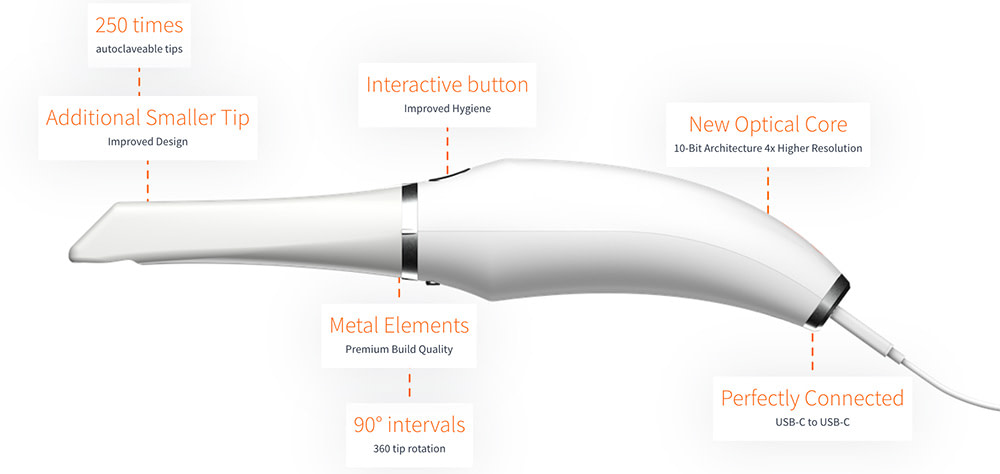
3Shape - TRIOS 6 is Launched.
3Shape unveiled their flagship TRIOS 6 at IDS 2025, representing a fundamental pivot in their approach to digital dentistry. Rather than focusing on hardware, 3Shape has transformed the scanner from a digital impression tool into a comprehensive diagnostic platform powered by sophisticated AI.
The scanner maintains the same physical design as the TRIOS 5 with a distinctive arctic sapphire blue finish, but integrates a interesting hyperspectral imaging system that simultaneously captures data using white light, fluorescence, and near-infrared technology. This multi-modal approach enables five powerful AI diagnostic capabilities - occlusal caries detection, quantitative tooth wear measurement, gingival recession tracking, plaque visualization without disclosing solutions, and proximal caries assessment.
What makes this system particularly impressive is that all five diagnostic analyses are performed from a single standard scan with no additional steps required. The scanner interfaces with the new TRIOS Dx Plus diagnostic software and connects patients to their oral health data through the DentalHealth mobile app, creating an ecosystem that extends care beyond clinical visits.
Priced at $27,900 USD, the TRIOS 6 represents 3Shape's strategic bet that the future of intraoral scanning lies not in incremental hardware improvements but in transforming the scanner into an AI-augmented diagnostic hub that engages both the dental team and patients in comprehensive oral health management.
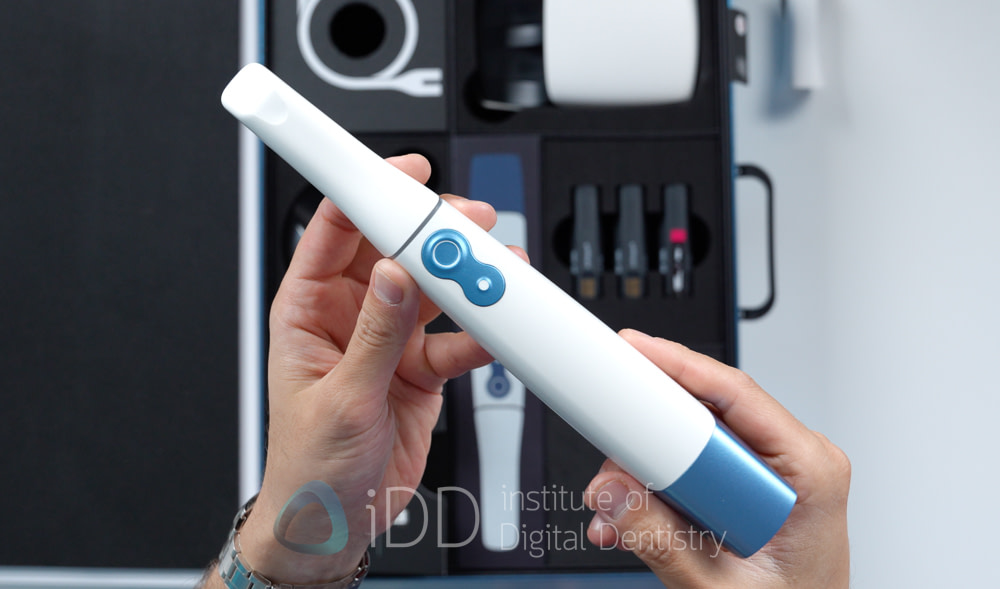
Arcreal - New Player Enters Scanner Market
A newcomer to the digital dentistry space, arcreal made their debut at IDS 2025 with the launch of their arcscan intraoral scanner alongside their arcgrid digital platform.
The arcscan features a lightweight design at just 200g but to me the nicest thing I saw about this scanner is the UI / UX. It is one of the nicest I have seen in any scanner software.
arcreal's marketing emphasizes their scanner's intelligent features and user-friendly experience. The company positions their product as part of a broader ecosystem with the arcgrid platform, which they describe as a future-ready cloud-based system connecting clinics, labs, and patients through AI integration.
As with any new entrant to the crowded scanner market, arcreal faces significant challenges in distinguishing themselves among established players with proven track records.
While their promotional materials make ambitious claims about redefining digital dentistry with AI, their success will ultimately depend on delivering tangible performance advantages and building market trust as a new brand in a field where reliability and support are crucial considerations.

ASIGA - PrintPods challenge the Midas?
ASIGA made a bold market move at IDS 2025 with the introduction of PrintPods, a fascinating pivot that transforms their existing MAX series printers into restorative-focussed solution. This development represents a strategic response to SprintRay's Midas system, offering a different approach to direct printed restorations. This has to be one of the biggest releases of IDS 2025.
Rather than requiring a dedicated printer, PrintPods uses a pod-based system that can be retrofitted to existing ASIGA MAX printers (with ULTRA compatibility planned for the future). Each small disposable cartridge costs approximately $25 USD and can be reused up to five times, significantly reducing the cost-per-print compared to dedicated systems.
The system maintains ASIGA's commitment to open materials, allowing you to use any compatible resin pod rather than being locked into proprietary formulations. The company announced ongoing validation processes with leading material manufacturers to ensure reliability across different restorative applications. Right now they have the popular PacDent resins and a number of others in pod format.
This approach offers advantages for practices that already own ASIGA printers, providing an entry path to chairside restorative printing without investing in entirely new hardware. The ability to use the same printer for both laboratory applications and direct restorations maximizes the return on existing equipment investments.
While still in the final development stages with "coming soon" status, PrintPods represents ASIGA's determination to remain competitive in the rapidly evolving direct printing market.
I will say that MIDAS still has the advantage of the ecosystem they have built and the press technology which apparently means better resins. This Asiga Pod system is not pressed. To me it seems like it is more in competition with the crown kit than the Midas itself, and Asiga just released a crown kit themselves at Lab Day in Chicago.
Regardless, this will be interesting to watch this play out, and if there was ever a declaration of war in dental printing, this is it.
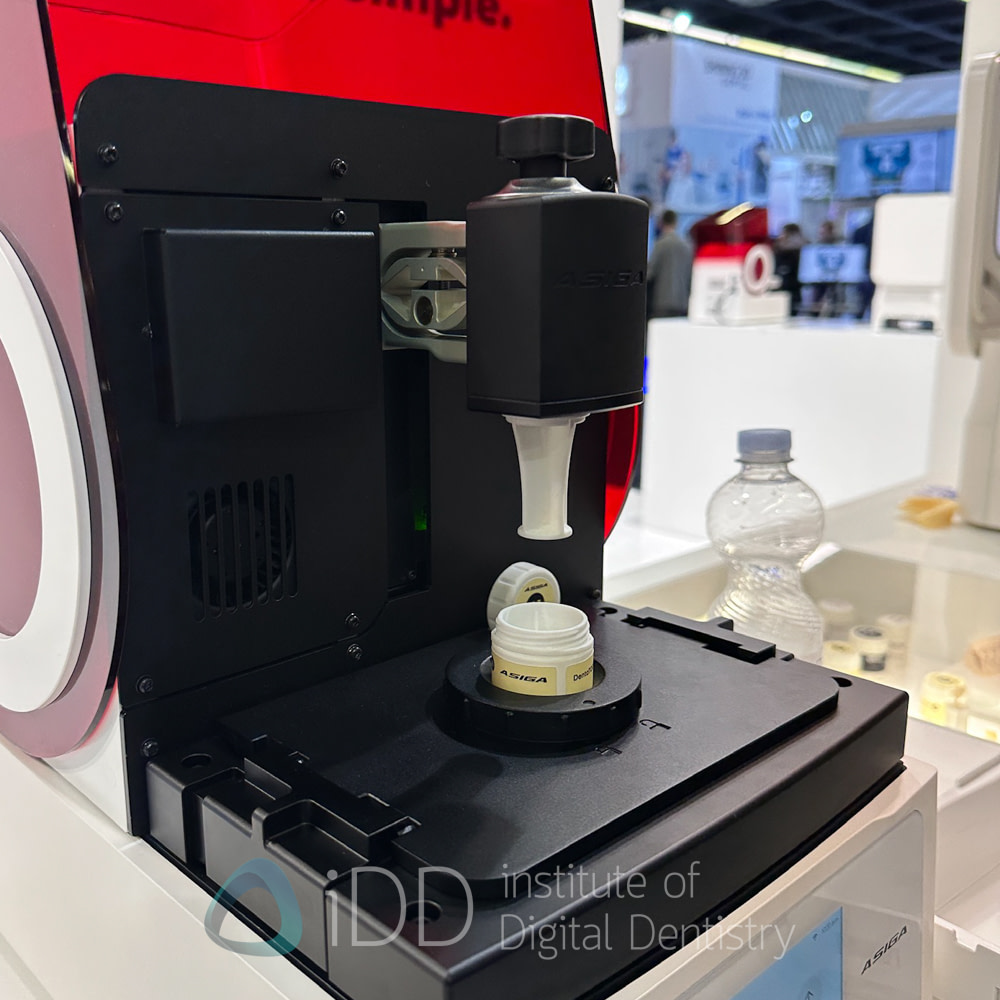
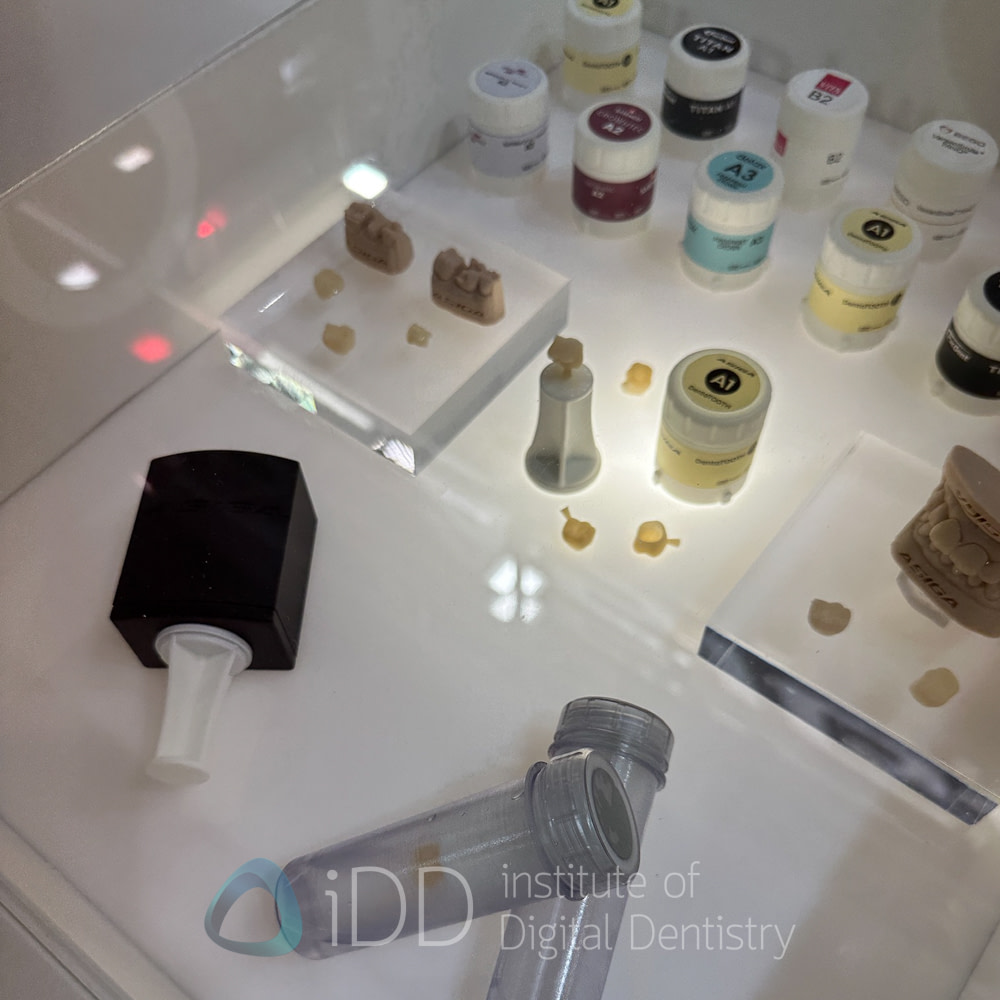
Aidite - Expanding Portfolio with Cameo Wireless Scanner
Aidite continued their strategic expansion beyond materials at IDS 2025, showcasing not only their CSF-400 Pro rapid sintering furnace, but also their new Cameo wireless intraoral scanner. This is the latest scanner alongside the Rapid 3.
The Cameo wireless scanner represents Aidite's latest venture into digital hardware, following their pattern of diversifying from their core zirconia manufacturing business.
While maintaining a low profile at the event compared to their materials-focused exhibits, the Cameo wireless scanner demonstrates Aidite's commitment to developing a comprehensive digital ecosystem. The scanner joins their growing equipment portfolio that now spans intraoral scanning, 3D printing, and sintering technologies.
Aidite's continued evolution from primarily a materials company to a provider of integrated digital solutions reflects the broader industry trend of traditional manufacturers expanding into complementary technologies. As one of the world's largest zirconia producers, their move into hardware gives them potential advantages in creating optimized workflows between their materials and equipment.
This steady expansion of their product range positions Aidite as an increasingly comprehensive provider in the digital dentistry space, leveraging their established reputation in materials to build credibility for their growing hardware offerings.
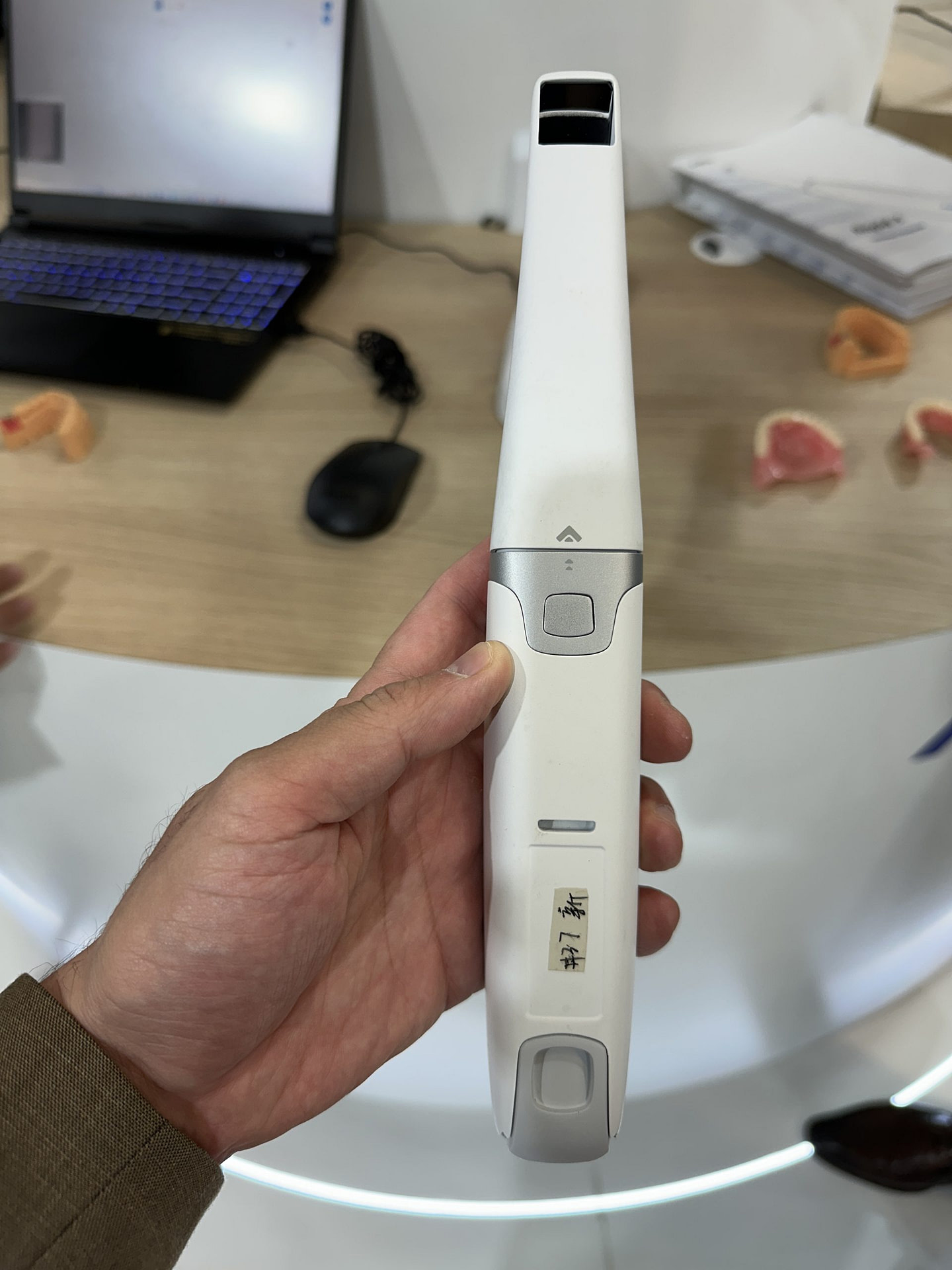
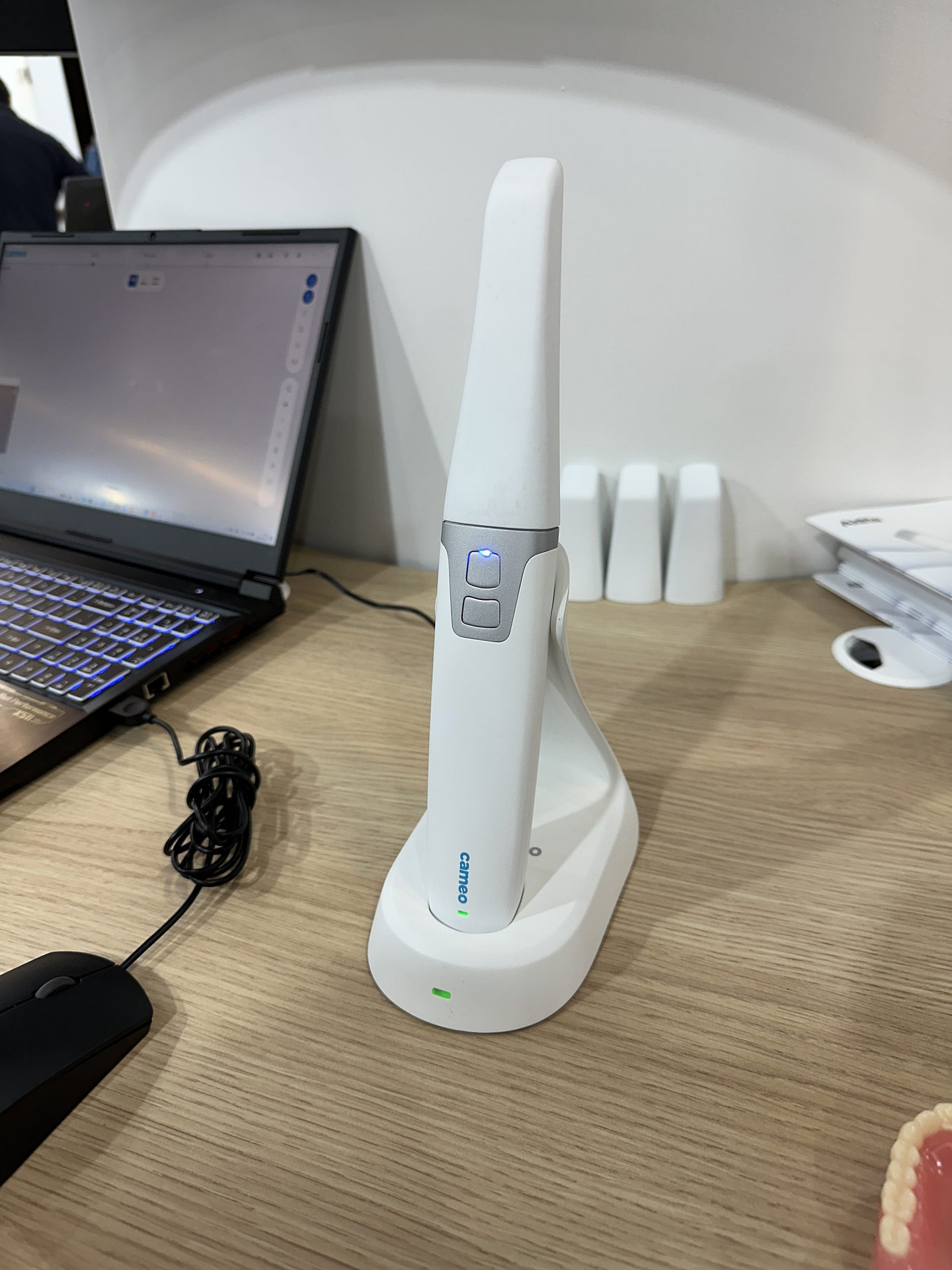
Alliedstar - New Flagship Intraoral Scanner
Alliedstar unveiled their new "Sensa" intraoral scanner at IDS 2025, expanding their product lineup beyond their established AS200E and AS260 models. This launch represents the company's first major product development since their acquisition by Straumann. Totally different naming scheme, new brand and a much better looking scanner.
The Sensa offers several advancements over Alliedstar's previous offerings, including improved scanning speed, totally redesigned hardware, wireless with no more removable batteries, wireless charging. The scanner maintains Alliedstar's approach of balancing performance with accessibility, rather than positioning itself as a expensive device.
This strategic addition complements Alliedstar's existing portfolio by offering an option for practices seeking more advanced capabilities without moving to a significantly higher price bracket. It also demonstrates how the Straumann acquisition is influencing the company's product development.
While pricing details weren't finalized at the show, the company indicated the Sensa would maintain their tradition of competitive pricing while delivering improved performance and capabilities.
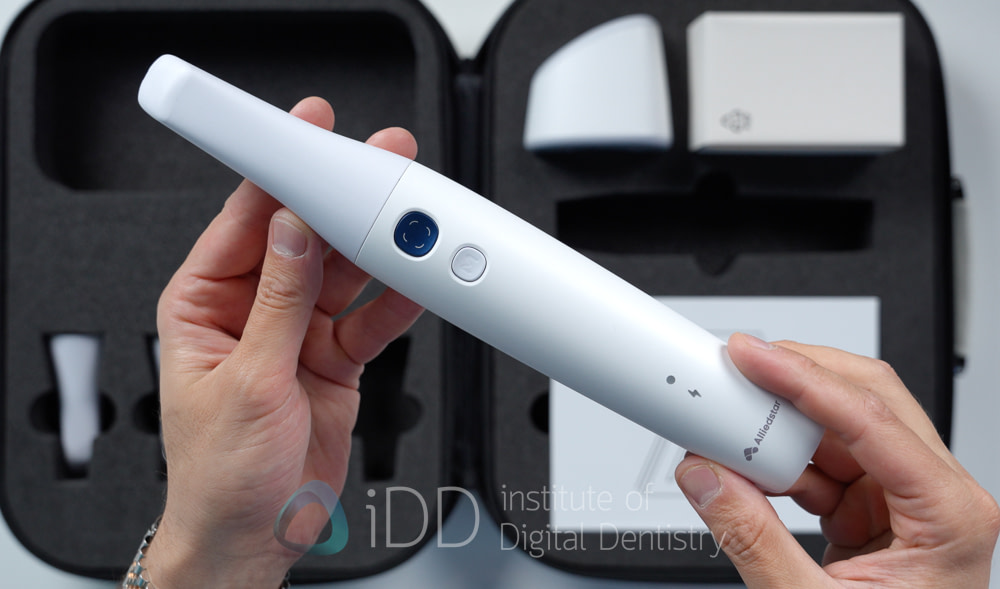
Screenshot
Atomica.AI - From Cloud CAD to Robotic Implant Placement
Atomica.AI delivered one of the most unexpected surprises at IDS 2025 with the preview of their handheld robotic implant drill, marking a dramatic expansion beyond their established cloud-based CAD solutions.
Unlike traditional dental robots that require large, stationary setups, Atomica's approach integrates robotic precision into a portable handheld device. The system combines AI-powered planning, optical tracking, and real-time feedback to guide clinicians with sub-millimeter accuracy during implant placement, providing safeguards against anatomical boundaries without sacrificing the tactile control dentists prefer.
While the handheld robot captured significant attention, Atomica also showcased substantial enhancements to their cloud CAD platform. Their Stackable Guide Module has been further refined with improved automation, the Crown AI Module introduced at Chicago Midwinter now supports both milling and 3D printing workflows, and a new AI-powered Smile Design module enables clinicians to generate printable veneers and mockups directly from intraoral scans.
Completing their hardware expansion, Atomica announced a new intraoral scanner that will be manufactured in the USA specifically for the American market, integrating seamlessly with their software ecosystem.
These developments position Atomica as a rapidly evolving competitor not just to other cloud CAD providers like DentBird, but potentially to robotic surgery companies like Neocis's Yomi system, with an approach that prioritizes accessibility and clinical workflow integration. Intersting pivot.
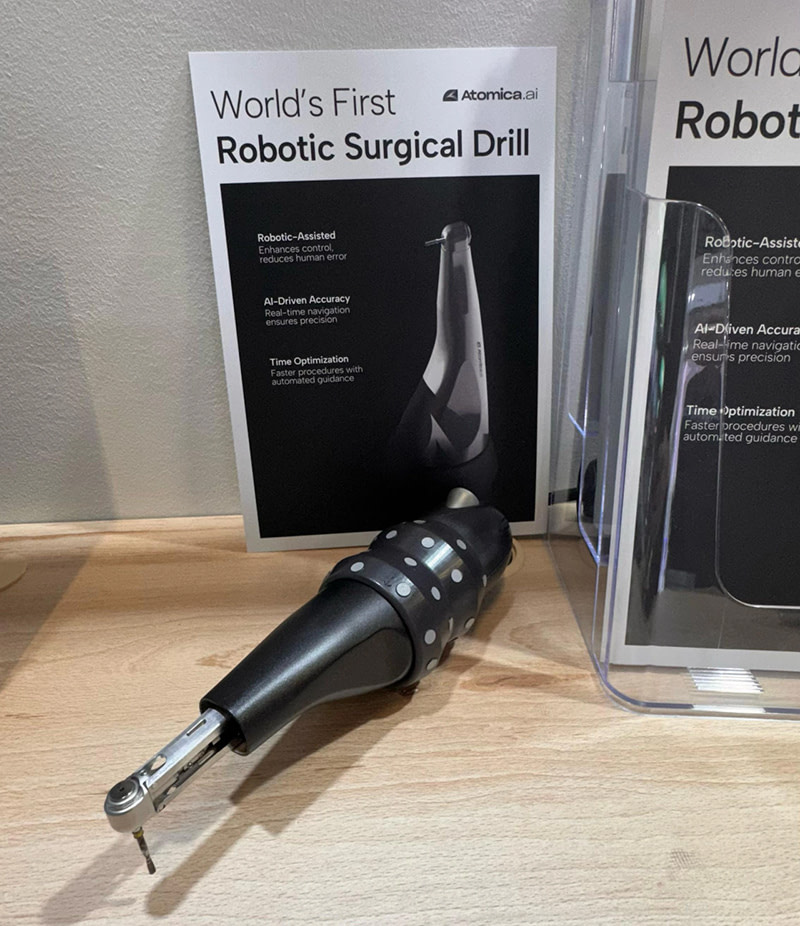
BenQ's Clear Aligner Production System: An Overview
BenQ made their entry into the dental market at IDS 2025 with a comprehensive in-house clear aligner production system. Their integrated solution enables practices to manufacture aligners from initial scan to finished product entirely within their facility, addressing the growing demand for on-site clear aligner production.
The system consists of three primary components working in concert: the DentCare BQP-D15 3D printer using DLP technology with 58μm XY resolution, the DentCare BQT-P01 Pressure Forming Machine that automates the thermoforming process with precise temperature and pressure control, and most impressively, the DentCare BQM-T4X Aligner Trimming Machine featuring 3+1 axis dry machining with AI-detected cutting paths.
What sets the BenQ system apart is its sophisticated software integration. Their QSlicer software connects all components into a seamless workflow with AI-assisted trimming line detection and batch processing capabilities. The system utilizes QR codes that link physical models to cloud-stored cutting data, ensuring each aligner is precisely trimmed according to its specific treatment step.
The automation extends to the trimming process, where once cutting paths are defined for the first model in a series, they can be automatically applied to subsequent steps, dramatically reducing the manual effort typically required in aligner production. The trimming machine achieves ±0.01mm accuracy with approximately 90-second processing time per aligner.
Priced at approximately $33,000 for the complete system ($5,000 for the printer, $5,000 for the thermoforming unit, and $23,000 for the trimming machine including 10 drill bits), BenQ offers a potentially viable alternative for practices with sufficient aligner volume to justify bringing production in-house. Unlike many dental software platforms, their system includes updates without additional annual fees.
BenQ's entrance into the dental space represents the growing trend of companies from adjacent industries bringing their manufacturing expertise to the rapidly expanding clear aligner market.
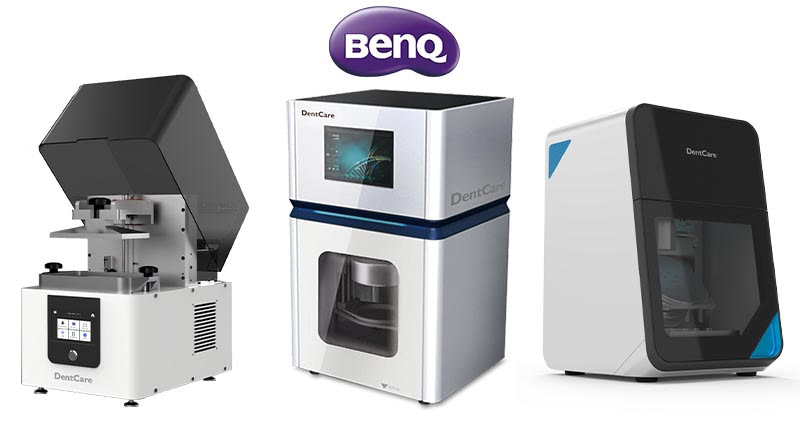
Biotech Dental - New IRIS scanner
Biotech Dental previewed their IRIS intraoral scanner at IDS 2025, prominently featuring their design collaboration with Philippe Starck. This marketing approach of attaching a famous designer's name reminds me of Carestream's Porsche Design partnership – I genuinely dont know if clinicians buy products because of this type of marketing.
In saying that, it is a well-designed product to be frank and looks very different to any other IOS on the market. It looks sleek and modern and the booth seemed to have constant interest.
The scanner employs a terminal camera system similar to the original WOW scanner. According to show information, IRIS is targeting a September 2025 launch with a price around $17,000 USD, placing it in the crowded mid-range scanner market where it may face stiff competition from established players.
I scanned with it. It did an OK job. It is a an extremely crowded scanner market and time will tell if IRIS delivers genuine innovation or if it's just a beautifully designed product that will find it hard to capture market share.
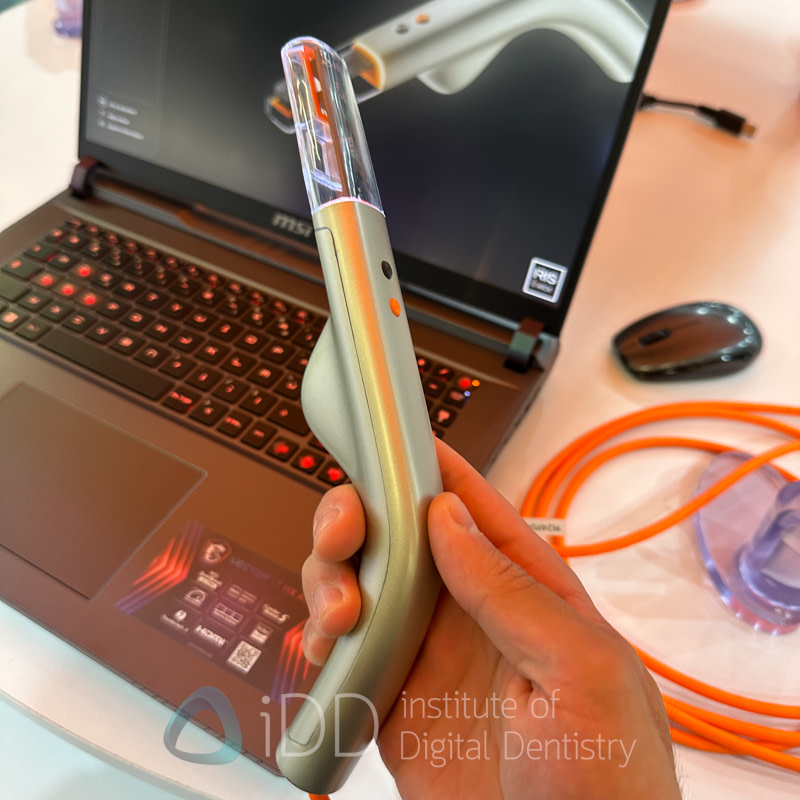
Dentsply Sirona - Primescan 2 gets Cloud-Native Upgrades
Dentsply Sirona highlighted substantial enhancements to Primescan 2 at IDS 2025, six months after its initial launch. The cloud-native intraoral scanner has received notable improvements that strengthen its position in the company's connected dentistry ecosystem.
Key upgrades include smart compression of files that reduces bandwidth requirements by up to 50%, making the scanner more accessible without as fast internet requirements. For EMEA markets, the scanner now offers integrated caries detection utilizing advanced near-infrared and fluorescence technologies, complementing conventional diagnostic methods.
Workflow improvements include significantly faster SureSmile simulations, with automatic tooth segmentation and smile simulation, with the company saying calculation times have been reduced by up to 90%. The company also announced an enhanced media library with more intuitive file storage and sharing capabilities.
Hardware releases include the new Primescan 2 Cart featuring an ergonomic design, wireless connectivity, built-in battery, and scanner charging capabilities. A new Multi-Use Steel Sleeve has also been released as an alternative to single-use options for Primescan 2. CEREC users will be familiar with these.
The DS Core platform continues to advance with regulatory clearance for 'Canvas' as a diagnostic viewer, enabling imaging customers to use DS Core for diagnostic purposes in most European countries, with US clearance expected later in 2025.
Dexis - Software Enhancements and Hardware Preview
Dexis focused on significant software advancements for their digital ecosystem at IDS 2025, while providing an exciting preview of their future hardware. The company showcased their upcoming flagship "Imprevo" intraoral scanner due later this year, featuring patent-pending technology that leverages parallel processing for more efficient data handling. The preview demonstrated enhanced graphics, advanced AI algorithms, a 20% slimmer design profile, increased depth of field, and notably faster scanning speeds with more realistic images.
Their software innovations were equally impressive. DTX Studio Clinic introduced several powerful AI-driven features, including automated "Initial Implant Position" that calculates optimal virtual teeth setup and 3D implant planning based on target tooth information and available scan data. The new "Endodontic Root Morphology" feature uses AI to visualize root canal systems in 3D, with tooth-by-tooth navigation and various rendering options specifically designed for endodontic procedures.
The imaging portfolio received notable updates, including cephalometric capabilities for the ORTHOPANTOMOGRAPH OP 3D EX and an intelligent Automatic Dose Control feature for the OP 3D LX that optimizes exposure settings based on patient anatomy. Their new 2D AI technology adds non-pathological data to automatically generate comprehensive overviews of patient dentition within the software.
Cloud capabilities were expanded with a preview of an upcoming "Cloud 3D Viewer" that enables practitioners to upload and share 3D scans with colleagues without requiring downloads or specialized software to view, annotate, and collaborate on cases. DTX now also supports face scan integration with either CBCT or intraoral scan data, allowing diagnostic planes to be added and exported as STL files for seamless lab collaboration.
While the Imprevo scanner represents Dexis's future hardware direction, their current IDS 2025 emphasis remained on maximizing existing equipment value through software enhancements and cloud connectivity, reflecting the industry-wide trend toward comprehensive digital platforms.
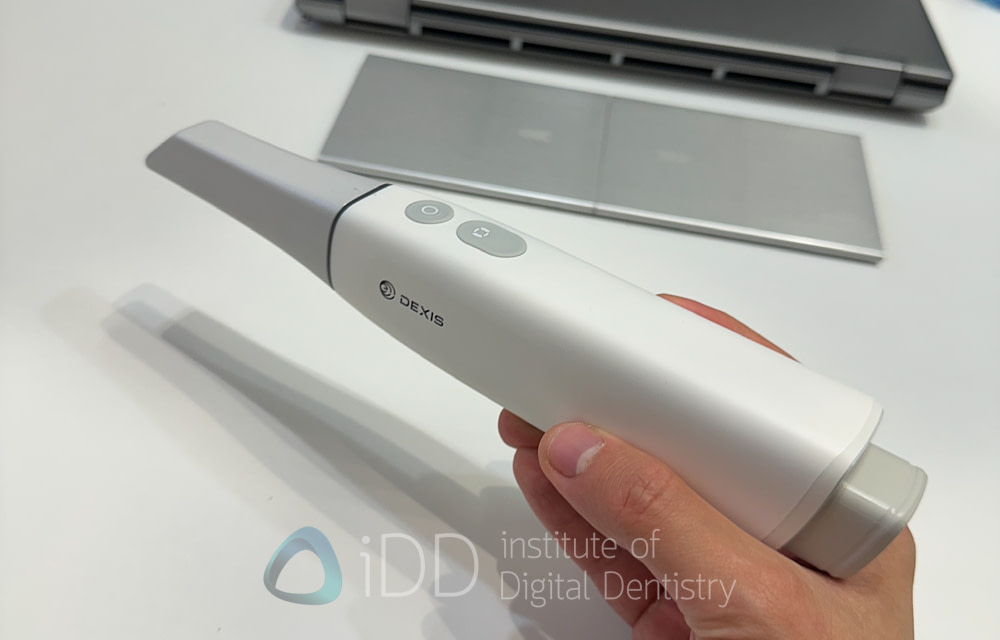
DOF - Photogrammetry Intraoral Scanner
DOF showcased a range of products at IDS 2025 with an extensive product lineup spanning the entire digital dentistry workflow, highlighted by their very interesting Freedom Air scanner that integrates photogrammetry directly into an intraoral scanner.
The Freedom Air represents DOF's strategic response to the growing demand for streamlined full-arch implant workflows. Unlike competitive approaches that require separate devices or scan bodies, DOF has integrated photogrammetry technology directly into the scanner itself. This innovation directly targets the space currently dominated by Shining 3D's Elite scanner but with a fundamentally different technical approach.
Complementing their scanner innovations, DOF showcased their comprehensive ecosystem including the CRAFT 5X all-in-one milling machine, CRAFT DRY precise milling unit, and ZIRFIRE rapid sintering furnace. Their DOF SOLID multilayer zirconia blocks rounded out their material offerings, positioning the company as a complete solution provider. For laboratory applications, DOF presented their Freedom X scanner featuring an ultra-high-resolution moving camera system designed for capturing detailed model scans with maximum efficiency.
DOF's innovative approach to integrating photogrammetry directly into scanning hardware could represent a significant advancement in simplifying complex digital workflows if it delivers on its promised capabilities.
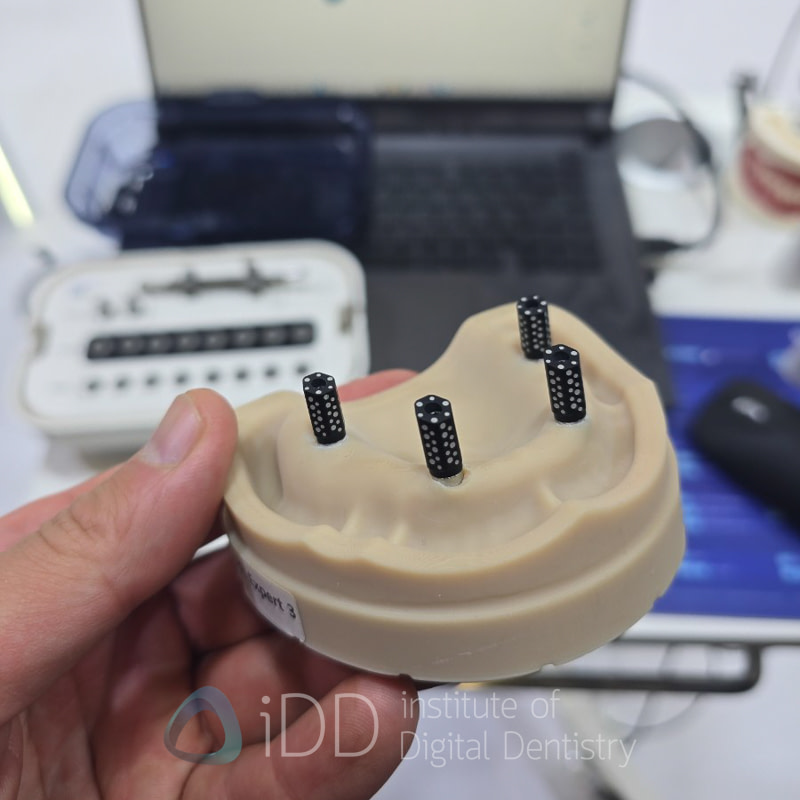
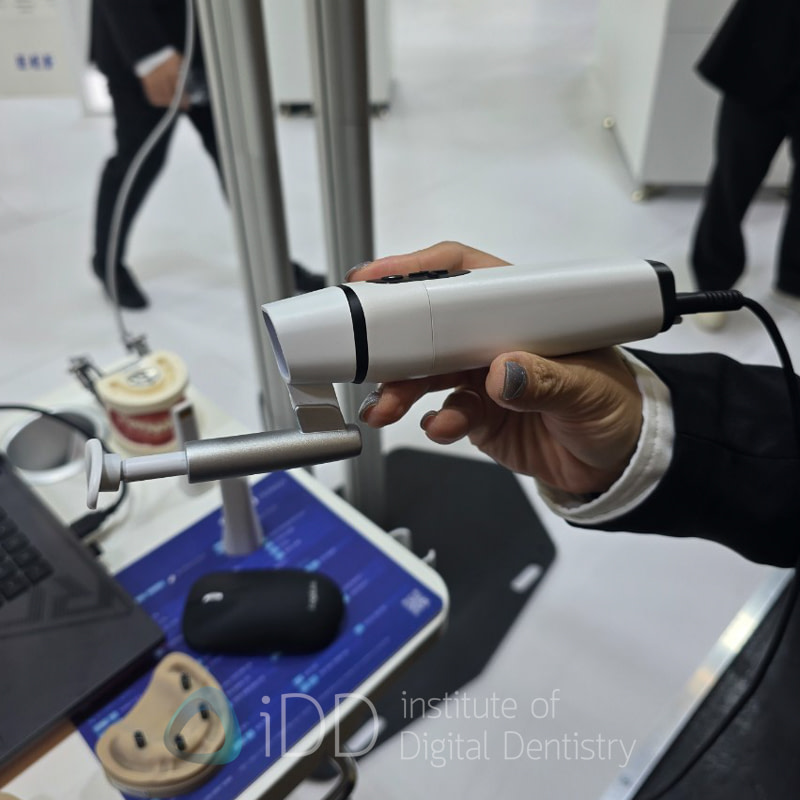
Fussen - Launches S10 Scanner
Fussen showcased their new S10 intraoral scanner at IDS 2025, continuing their expansion into the digital impression market. It has a interesting feature - different operational modes being "FAST" and "PRECISE" - to accommodate various clinical scenarios.
The "FAST" mode offers 30 fps scanning speed for efficient capture of standard cases, making it suitable for routine impressions where speed is a priority. Meanwhile, the "PRECISE" mode provides enhanced depth of field (22mm) for capturing deeper preparations and detailed margins in more complex restorative cases.
Alongside this scanner Fussen also showed some very interesting AI CAD software they are developing. This seems to be a growing trend in all competitive intraoral scanner companies.
The continued evolution of Fussen's tech lineup demonstrates how rapidly Chinese manufacturers are advancing in the digital dentistry space, bringing increasingly capable technology to market at competitive price points.
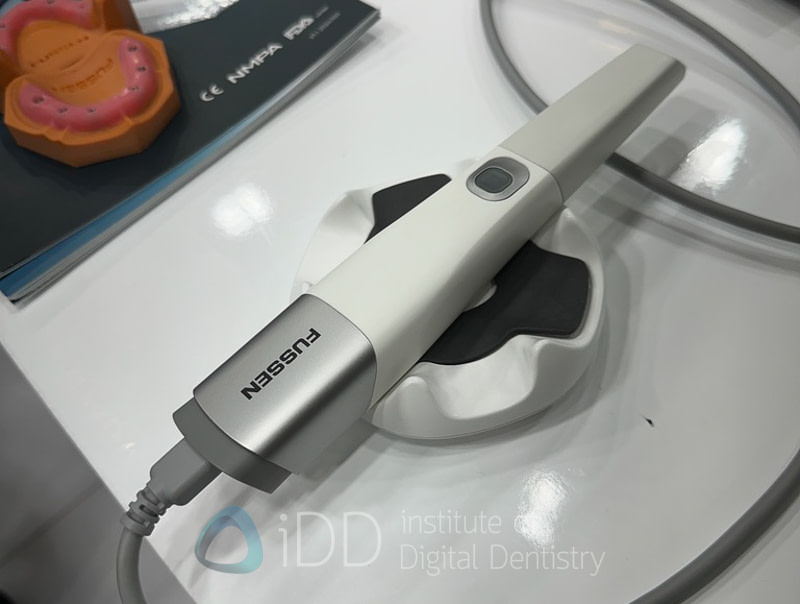
Formlabs Dental - Open Material Mode + New Form Cure
Formlabs highlighted two major developments at IDS 2025 - their Open Material Mode for the Form 4B and the launch of their Form Cure (2nd Generation).
Open Material Mode first announced at Chicago Midwinter, enables Form 4B printers to work with any 405nm photopolymer. Formlabs showcased validation for Dentsply Sirona Lucitone Resin and PacDent resins. The validation for the Lucitone Digital Print Denture System is particularly interesting as it positions the Form 4B as a affordable option for the industry's leading denture material, while the PacDent partnership brings Rodin Titan and Sculpture 2.0 resins to the platform.
The highlight of their hardware offerings was the new Form Cure (2nd Generation), a high-efficiency curing box that beats the previous generation models in almost everyway. Replacing both the original Form Cure and Fast Cure devices, it delivers dramatically faster curing times for all dental applications. This upgraded system features pre-programmed settings, near-instant heat-up, and the ability to cure all dental objects within 10 minutes, with capacity for up to 15 models per minute.
Big day for Formlabs Dental. The first time ever their prints are open. Market pressure in action and these developments reflect Formlabs' strategic focus on both open material accessibility and streamlined post-processing for a complete dental production ecosystem.

HeyGears - Multi-Material Fusion and Automated Production
HeyGears continued to build upon their impressive Lab Day Chicago showing by showcasing further advancements in their multi-material fusion technology at IDS 2025. This innovative approach to dental 3D printing generated significant interest, with demonstration samples illustrating how their DLP technology can achieve multi-color prints from a single resin system.
The results on display were nothing short of impressive, with striking color variations and transitions that could open new possibilities for dental applications. While still primarily a technology demonstration, the practical implications for dental restorations are significant.
Their A2D HD printer also maintained a strong presence, highlighting its production capabilities for high-volume laboratories and clinics. The system's automated features, including one-click part removal and automatic chip recognition for materials, reinforce HeyGears' focus on reducing the technical barriers to efficient dental manufacturing.
Perhaps most intriguing was their large volume processing unit, designed for industrial-scale production environments that require consistent, high-throughput manufacturing. This system further demonstrates HeyGears' commitment to addressing the full spectrum of high volume dental production needs.
With continued innovation in both materials science and automation technology, HeyGears is establishing itself as a company to watch closely in the dental 3D printing space, particularly for practices and laboratories looking to scale their digital manufacturing capabilities.

iTero - The Lumina Gets Restorative Capabilities + NIRI
Align Technology used IDS 2025 to showcase the long-awaited restorative capabilities for their Lumina scanner, fulfilling a promise that had been pending since the scanner's initial release in early 2024. The new "Lumina Pro" software upgrade transforms what was previously an orthodontic-focused scanner into a comprehensive restorative solution.
The restorative capabilities include full-contour design integration, margin detection, and comprehensive prosthetic workflows. What's particularly notable is that these features are purely software-based - the hardware remains identical between the standard Lumina and the new Lumina Pro, with the only difference being the addition of Near Infra-Red Imaging (NIRI) technology in the Pro model.
Align made some bold claims about the scanner's capabilities, including accuracy "within the threshold of photogrammetry for full-arch implant restorations" - a significant statement considering most competitors now offer specialized scan bodies or separate photogrammetry solutions for this application. The company published benchmarking tests claiming the Lumina showed "significantly higher" accuracy compared to competitors including TRIOS 5, CS3800, Medit i700, and AlliedStar.
The integration with Align's new "iTero Design Suite" - their cloud-based version of exocad software - creates a streamlined workflow from scanning directly into design without requiring third-party software, though the system maintains an open architecture for practices preferring alternative design solutions.
While the restorative capabilities arrive significantly later than initially expected, they represent Align's serious push beyond their traditional orthodontic stronghold into the restorative digital workflow space long dominated by competitors like 3Shape and Medit.
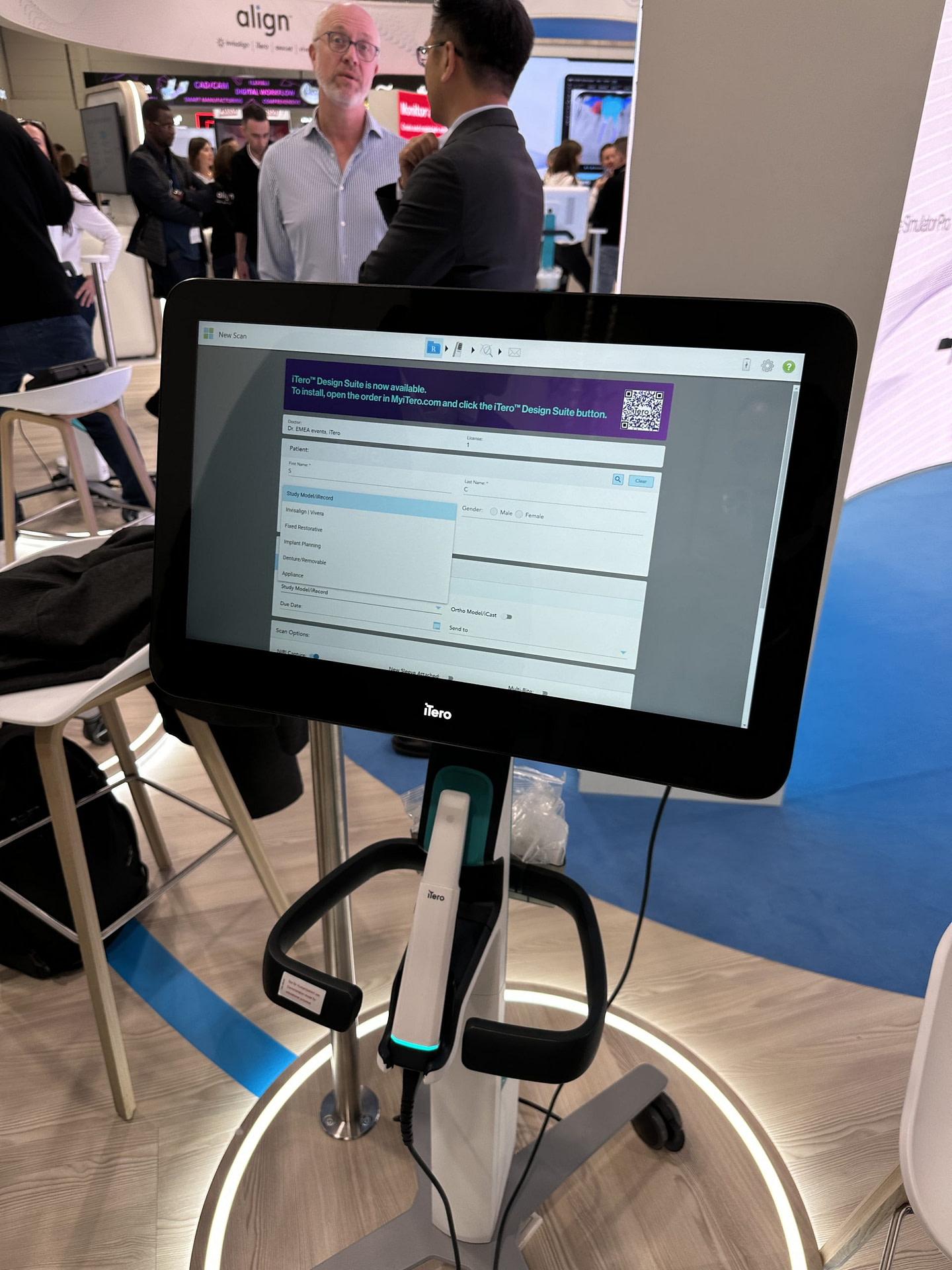
Lilivis - OCT Scanning Technology
Lilivis delivered one of the most surprising innovations at IDS 2025 with the unveiling of their prototype OCTIX scanner, which utilizes Optical Coherence Tomography (OCT) technology rather than conventional intraoral scanning methods.
Unlike traditional intraoral scanners that capture only surface data, this approach enables visualization through tissues - reportedly up to 0.5-1mm through enamel and through gingival margins. This capability could transform restorative dentistry by allowing clinicians to see subgingival margins, detect early caries beneath seemingly intact enamel, and allow for the measurement of enamel thickness.
Although it is a prototype for now, and when I tried it, it was quite slow, it is a fascinating approach to intraoral scanning. I will be watching this closely to see how it develops over the years. This technology represents a potentially disruptive advancement in digital impression technology.
If Lilivis can successfully bring this product to market with the capabilities demonstrated, it could address some of the most persistent issues clinicians have with digital impressions - particularly visualization of deep subgingival margins and detection of conditions beneath intact tooth surfaces.
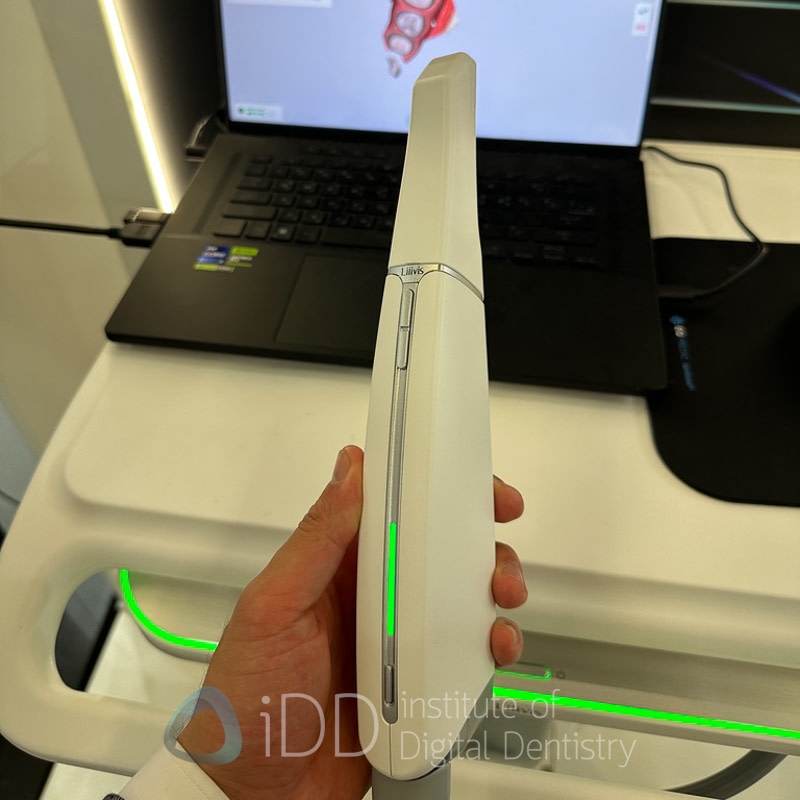
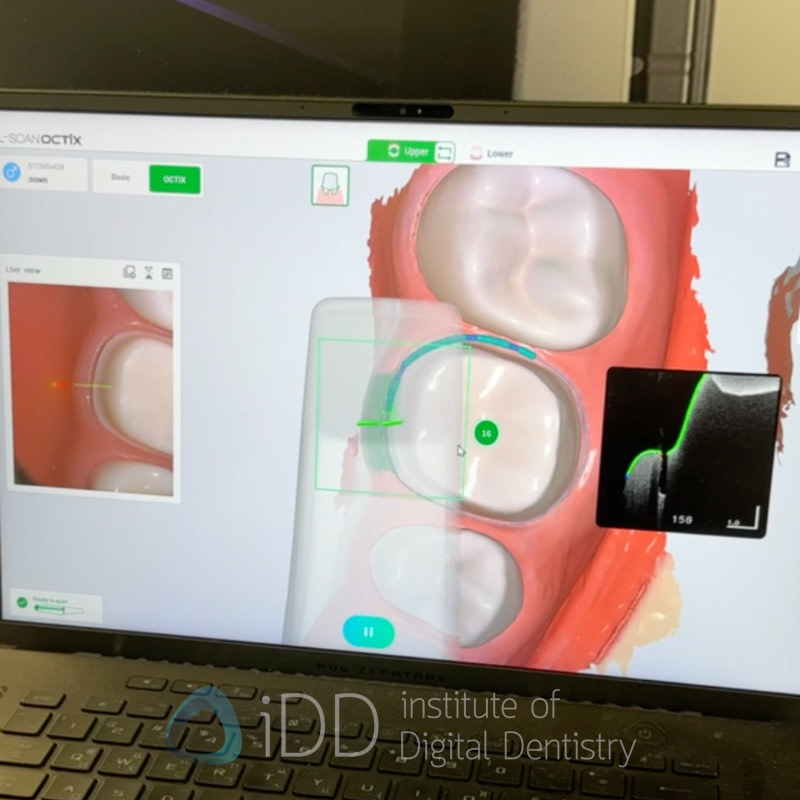
Medit - i900 Classic Brings Back the Button
Medit showcased their recently announced i900 Classic at IDS 2025, addressing one of the main annoyances of their flagship scanner - the touch controls that replaced physical buttons in the original i900.
The i900 Classic maintains all the same hardware the original i900 - the excellent optical engine, wider scanning window, and lightweight design - while reintroducing a physical button for clinicians who found the touch interface challenging in everyday practice. It's essentially the same scanner with a more traditional control option, demonstrating Medit's responsiveness to user feedback. Both options exist by the way - you can choose if you want to buy the touch control option or button option.
At IDS, Medit also highlighted their new workflow for full-arch implant scanning using Scan Ladder or Apollo abutments - a clear response to the growing trend of horizontal scan bodies pioneered by Shining 3D's Aoralscan Elite. This addition complements their already comprehensive software ecosystem, which remains one of their strongest selling points despite recent changes to their app pricing structure.
A relatively tame release compared to the groundbreaking innovations we've seen elsewhere at IDS, but one that shows Medit is listening to their users.
ModJaw - Sphere Platform Advances 4D Dentistry
ModJaw showcased their innovative Sphere platform at IDS 2025, representing a significant advancement in their 4D digital dentistry ecosystem. This cloud-based platform enables seamless collaboration between clinicians and dental technicians through AI-powered tools that transform jaw movement data into practical design information.
The Sphere platform pre-launched at IDS alongside TWIM 3.6, their latest software release featuring numerous workflow enhancements. Key among these are automatic selection of in-mouth picking points, automated motion recording selection, AI-powered condylar slope calculations, and virtual condyle positioning for patients with temporomandibular disorders.
What sets Sphere apart is its suite of AI-powered features, including "Crop Motion" which helps select the most relevant movement sequences for design, "One Click Motion Generation" for creating patient-specific jaw movements, and "Mock-up Virtual Testing" for evaluating proposed treatments. The platform includes real-time collaboration tools with built-in chat functionality, eliminating communication barriers between clinicians and technicians.
The workflow is straightforward: clinicians capture patient motion in TWIM and share it through Sphere, where dental technicians can access and process the data without needing specialized software—just a web browser. After activating the workflow for a specific case, technicians can utilize Sphere's AI tools, simulate new vertical dimensions, and export the refined data to CAD software like exocad or 3Shape Dental System.
ModJaw's continued innovation in functional analysis positions them as pioneers in what they call "4D Dentistry"—adding the dimension of real patient movement to traditional 3D digital workflows for more precise, patient-specific restorations.
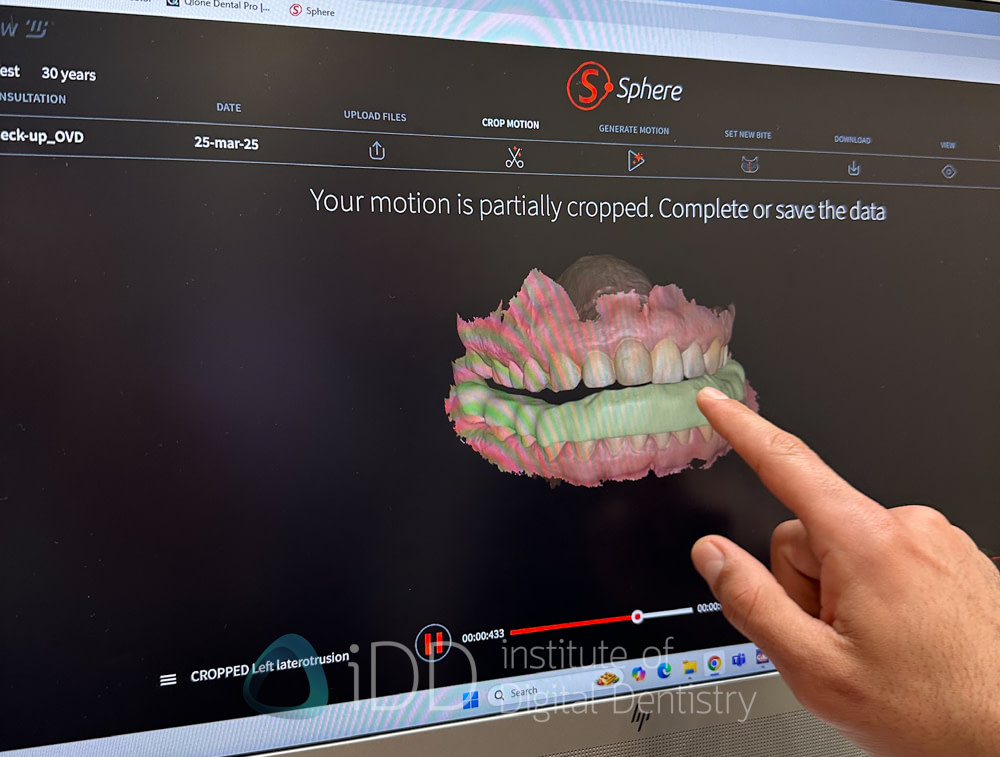
Panda Free Scanner - New Wireless Scanner and Cart
Panda introduced new products that expand their intraoral scanning ecosystem - the PANDA Free wireless scanner and the BAMBOO Ultra cart system.
The PANDA Free wireless scanner represents the company's entry into the increasingly competitive wireless scanner market. Living up to its "Free Your Scanning" tagline, this device is one of the smallest wireless scanners on the market. The device is notably lightweight at just 178g.
Complementing their scanner lineup, Panda also introduced the BAMBOO Ultra cart, a mobile workstation designed specifically for their scanners. The BAMBOO Ultra includes thoughtful design features like a built-in 144Wh battery that supports a full workday of usage and integrated WiFi 7 and Bluetooth 5.4 connectivity. A dedicated bracket system ensures stable placement of Panda scanners on the cart.

Phrozen - New Sonic CS+ Targets Accessible Chairside Printing
Phrozen made a strong showing at IDS 2025 with multiple product launches spanning both chairside and laboratory applications, firmly establishing themselves as a full-spectrum dental 3D printing provider.
Their new Sonic CS+ headlined the chairside offerings, designed specifically to lower barriers to entry with its $3,500 USD price point. This 385nm LCD printer delivers impressive 22μm XY resolution while prioritizing simplicity with a streamlined workflow that promises setup to printing in just 10 minutes. The printer's "print-to-patient" workflow completes restorations in approximately 45 minutes, making same-day treatments practical even for practices new to 3D printing. The system offers two build plate options - a standard kit (14.5 x 7.1 x 17.5 cm) for maximum output and a mini kit (7 x 7 x 17.5 cm) for faster printing when needed.
For laboratory applications, Phrozen introduced an expanded lineup of production-focused printers including a new metal printing solution aimed at the growing demand for printed frameworks and partial dentures. This move into metal printing represents a significant expansion of their technology portfolio and addresses a critical manufacturing need that has traditionally required casting or milling processes.
Complementing their printer lineup, Phrozen unveiled their innovative Heat & Mix system, a handsfree resin mixing station that helps with one of the most tedious aspects of 3D printing workflow. The device uses multidirectional mixing (rolling, up/down, and back/forth movements) to ensure thorough homogeneity of materials containing fillers or pigments. This practical solution addresses a common cause of print failures - improperly mixed materials - while eliminating messy manual shaking processes.
The comprehensive ecosystem approach demonstrated at IDS 2025 positions Phrozen as a serious competitor across the dental 3D printing spectrum, from affordable entry-level solutions to sophisticated production equipment for specialized applications. Their focus on simplifying workflows while expanding material capabilities shows a sophisticated understanding of the practical challenges in implementing printing technology in both clinical and laboratory settings.
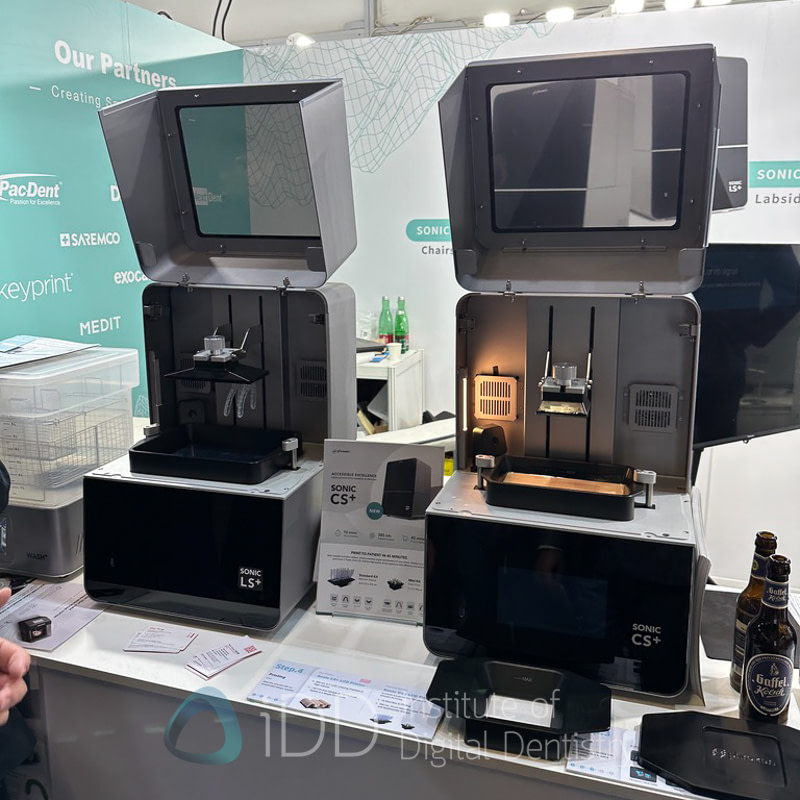
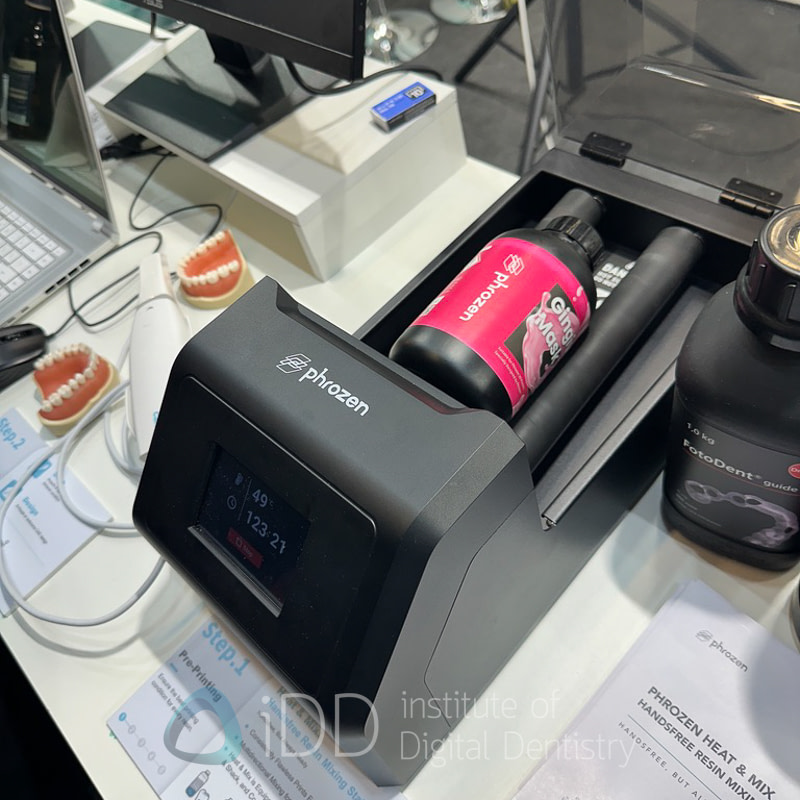
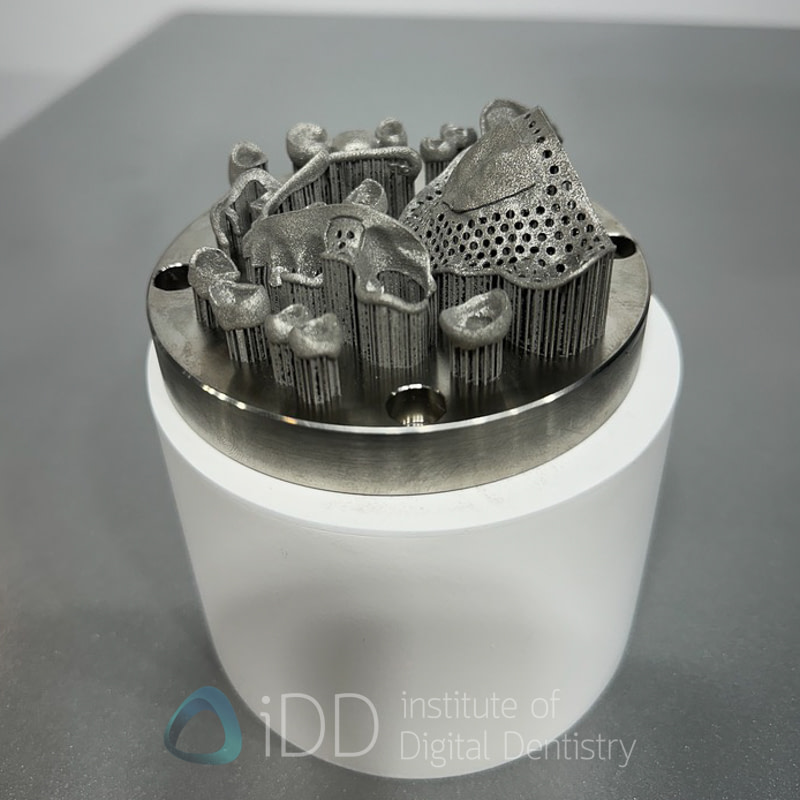
Planmeca - Finally Refreshes Scanner Lineup with Onyx
Planmeca made a significant announcement at IDS 2025, unveiling the long-awaited successor to their Emerald scanner. The new Planmeca Onyx intraoral scanner arrives a full six years after their previous model, marking an end to what had become one of the longest hardware refresh cycles in the scanner market.
The Onyx represents a redesign and the companies first wireless scanner. The scanner introduces a new optical system and LED light source that reportedly enhance scanning speed and precision while maintaining accuracy across all dental indications.
One issue - it is not out until later in the year, as I was told they are still sorting some things out.
Beyond the scanner, Planmeca showcased their comprehensive digital ecosystem, including the new Romexis 7 software with integrated AI capabilities. The AI tools, now standard features rather than premium add-ons, are designed to complement clinician expertise in patient assessment and treatment planning.
The company also expanded their imaging portfolio with the Viso G1 CBCT unit, featuring an 11x11cm FOV and advanced sensor technology, alongside two new Viso 2D panoramic imaging devices. Their CAD/CAM lineup was strengthened with the Onyx Lab desktop scanner for digitizing models and impressions, and the redesigned Creo X 3D printer for restorations, surgical guides, and appliances.
After years of relative quiet on the hardware front, Planmeca's comprehensive product refresh across all categories signals their commitment to maintaining relevance in an increasingly competitive digital dentistry market.
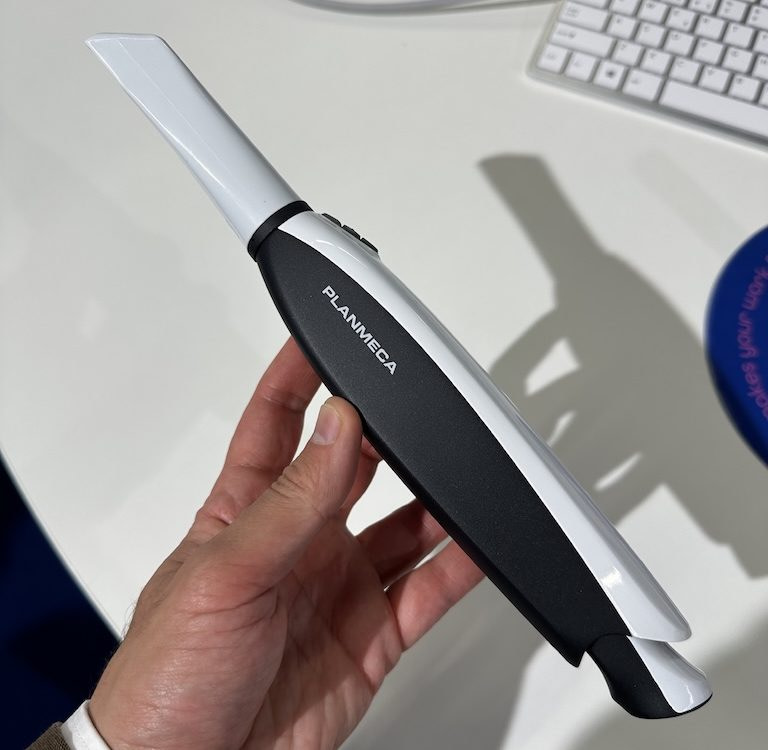
PIC Dental - Phone App Pivot Revolutionizes Their Ecosystem
PIC Dental made a significant strategic shift at IDS 2025, showcasing their comprehensive photogrammetry options with a particular focus on their new smartphone-based solution. This pivot toward mobile technology possibly represents their response to the growing popularity of horizontal scan bodies from competitors like Shining 3D and TruAbutment.
In discussions with PIC Dental's CEO, the company demonstrated their smartphone application that transforms ordinary mobile devices into powerful photogrammetry tools. This subscription-based service is priced at $59 per month, with an initial investment of $2,500 for ten PIC flags. The app itself has been in development for years, resulting in an impressive and user-friendly interface.
The system offers an accessible entry point to high-precision implant position capture without requiring expensive dedicated hardware. However, there is an additional cost structure - each exported implant position incurs a $16 fee, creating a usage-based revenue model alongside the subscription.
This approach strategically positions PIC Dental to compete in the increasingly crowded full-arch digital workflow market by significantly lowering the barrier to entry. Rather than requiring a substantial upfront investment in specialized equipment, practitioners can leverage devices they already own while maintaining PIC Dental's renowned accuracy.
The smartphone-based solution complements PIC Dental's existing professional-grade photogrammetry offerings, giving the company a comprehensive portfolio that addresses different price points and practice types. This versatility will be interesting to watch as the market continues to evolve between dedicated photogrammetry solutions and the horizontal scan body approach pioneered by other manufacturers.
The comprehensive ecosystem now features multiple hardware configurations to suit different practice needs: a compact "pocket" version for maximum portability, a desktop "station" setup, and their flagship "gravity" system with an articulating arm for optimal positioning. The tiered approach offers flexibility, allowing practices to select their ideal implementation based on workflow preferences and budget constraints.
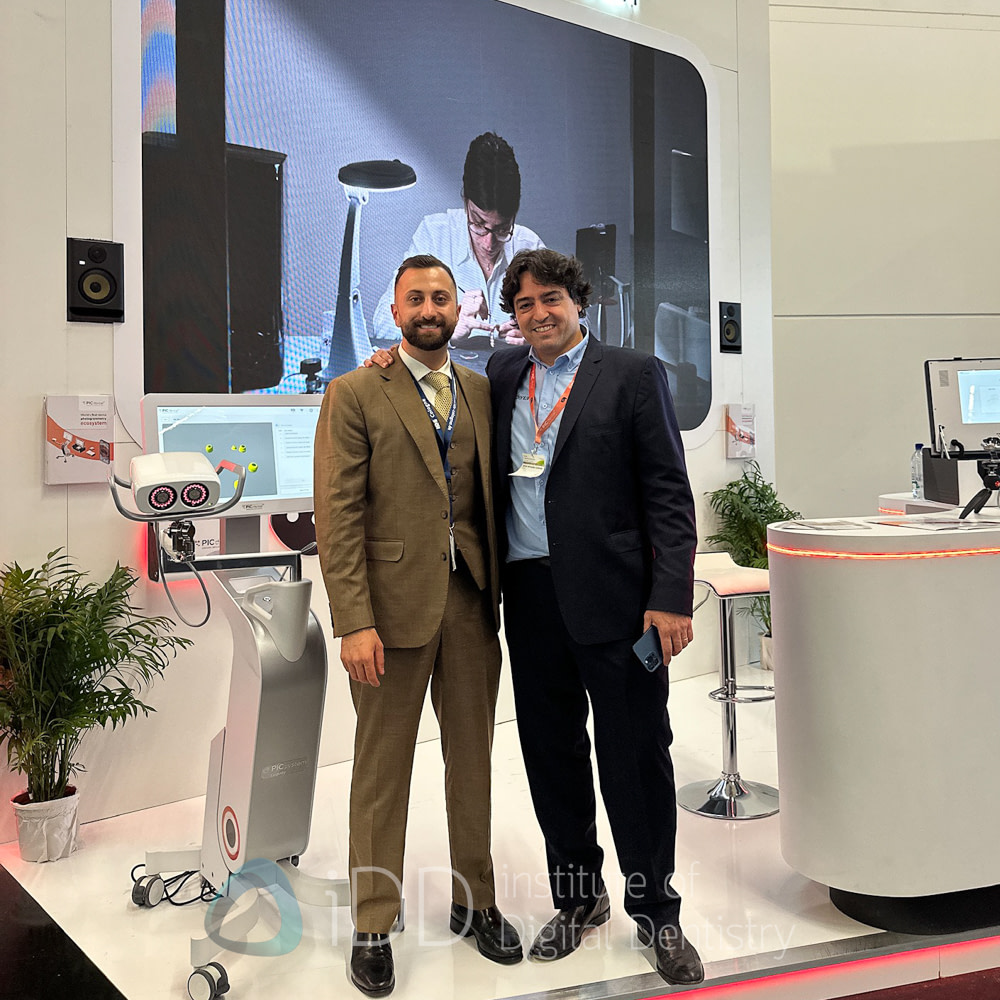
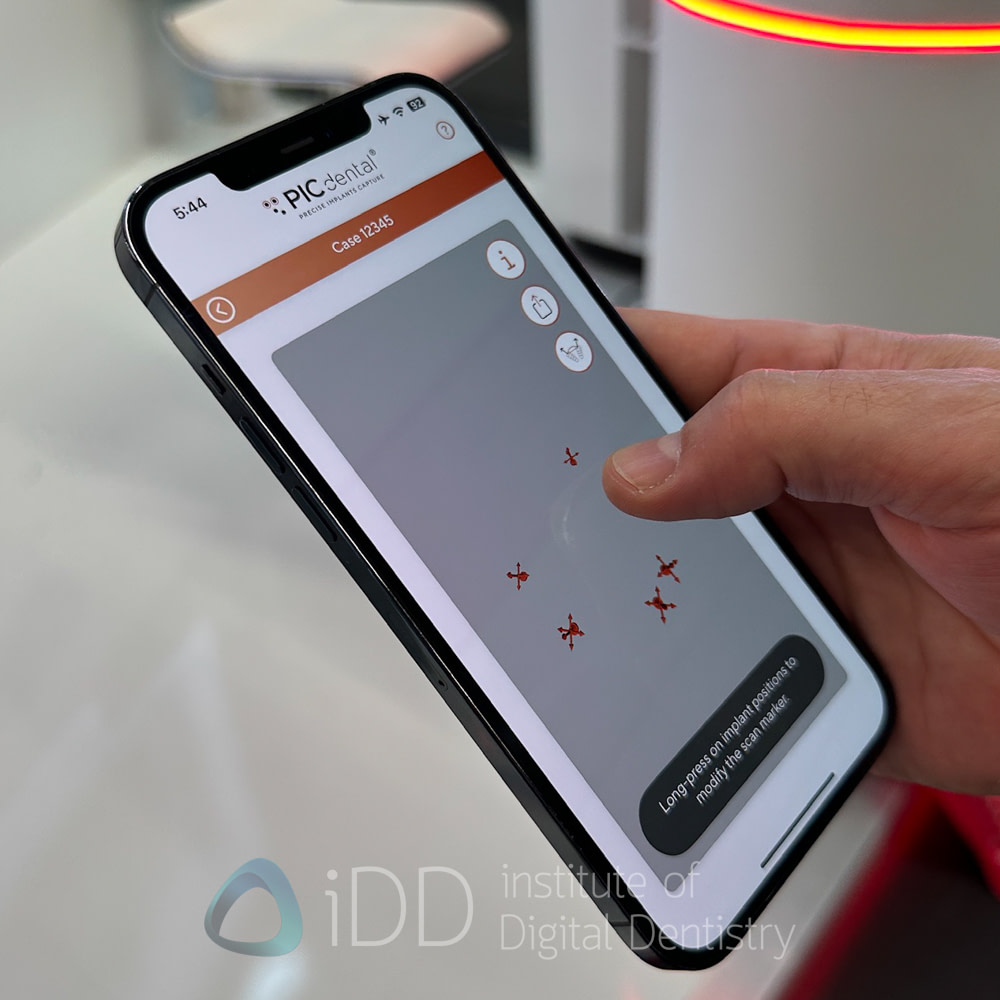
RapidShape - New ONE Printer Targets Chairside 3D Printing
RapidShape made a strategic entry into the rapidly growing chairside printing market at IDS 2025 with their new ONE printer specifically made with dental practices in mind. This is a 385nm DLP printer with 15 different resins validated for it and a revamped printer software.
The system's footprint was clearly designed with operatory space constraints in mind, with the complete solution (printer, wash, and cure units) requiring far less space than previous RapidShape printers.
The system's includes a Rapid Crown Kit, which enables practices to print crowns and bridges in around 15 minutes, followed by a 10-minute post-processing cycle. The post-processing workflow has been streamlined with the ONE wash and ONE cure units, which feature one-click operation and smart connectivity between devices. The wash unit includes a hands-off cleaning and drying process, while the cure unit utilizes vacuum technology.
RapidShape joins the growing number of companies focusing on chairside printing solutions at IDS 2025, further validating the industry's shift toward bringing manufacturing capabilities directly into the clinical environment. Interesting move for the company as its tries to find its footing in this competitive landscape.
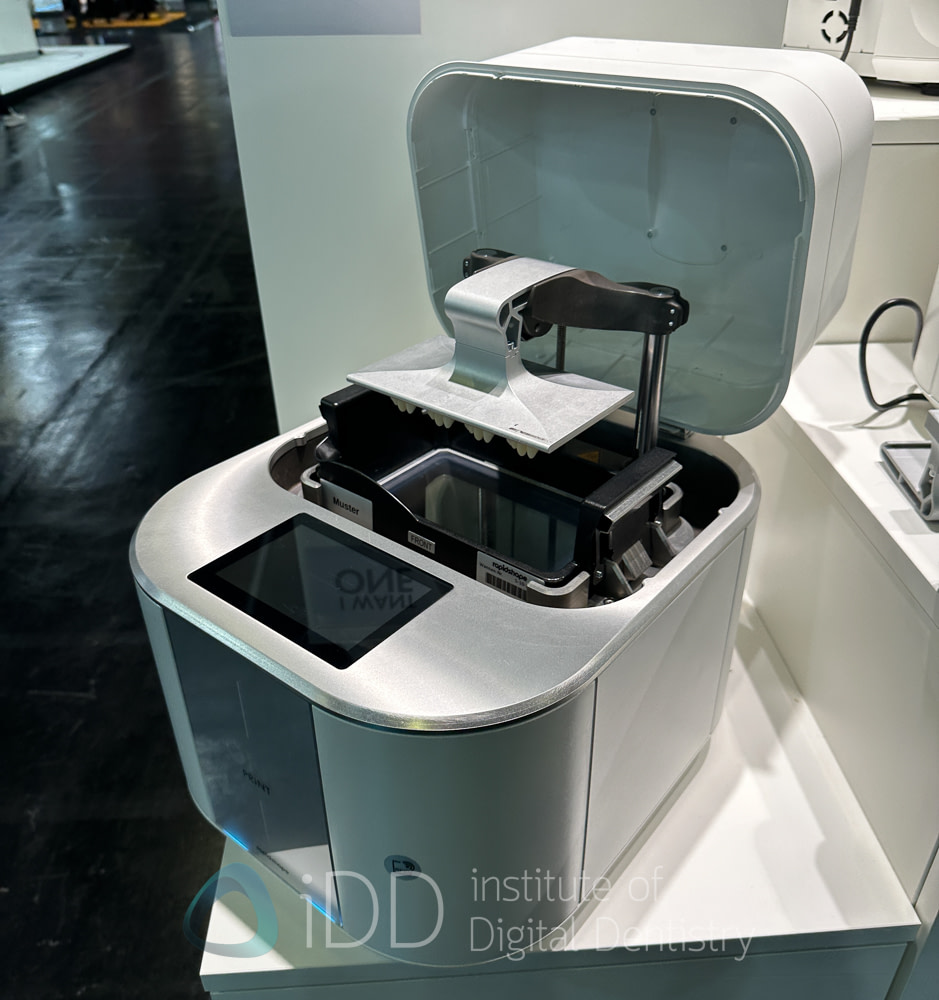
Ray - 5D CBCT System combines CBCT + Facescan and AI
Ray officially launched their innovative "5D CBCT" system at IDS 2025, following its preview at AEEDC earlier this year. This system integrates advanced CBCT technology with a RayFace face scanner attachment in a single cohesive unit.
The system's strength lies in its sophisticated software, which automatically aligns CBCT volumetric data with facial scans and performs intelligent segmentation. This creates a comprehensive digital patient model combining both internal and external anatomical information without requiring manual alignment.
The "5D" designation refers to the system's ability to capture multiple imaging dimensions simultaneously, providing clinicians with a more complete diagnostic picture than traditional CBCT units. This integration creates particularly valuable visualization capabilities for treatment planning in orthodontics, orthognathic surgery, and implant rehabilitation.
While Ray faces increasing competition in the face scanning arena with several new entrants at IDS 2025, their approach of deeply integrating radiographic and surface data in a single system offers a unique advantage. By handling the complex alignment process automatically, the 5D system streamlines diagnostic workflows while enhancing the quality of patient information available for treatment decisions.
Listen to Our Podcast with Yohan Kim, Chief Commercial Officer of Ray, as he reveals how their groundbreaking technology is transforming digital dentistry workflows.
Rodin - Nitrogen-Free Glazing and Rapid Ceram Resin
Rodin unveiled two products at IDS 2025, further expanding their portfolio of materials for 3D printed restorations. The company introduced their Palette 2.0 Naturalizing Kit with Glaze N2-Free, addressing one of the most persistent challenges in 3D printing, which is post-processing.
The standout feature of the Glaze N2-Free, is the company says it neutralizes the oxygen inhibition layer that typically forms during light curing. This apparently eliminates the need for nitrogen chambers or vacuum environments in the curing process. The glaze ensures complete polymerization and eliminates tacky surfaces, resulting in smooth and glossy finish.
Additionally, Rodin launched their new Rapid Ceram resin, which according to sources at the show, offers essentially the same quality as their popular Sculpture resin but with faster printing times. This development addresses one of the primary concerns in chairside applications, production speed, without compromising the material properties that have made Sculpture popular among dental professionals.
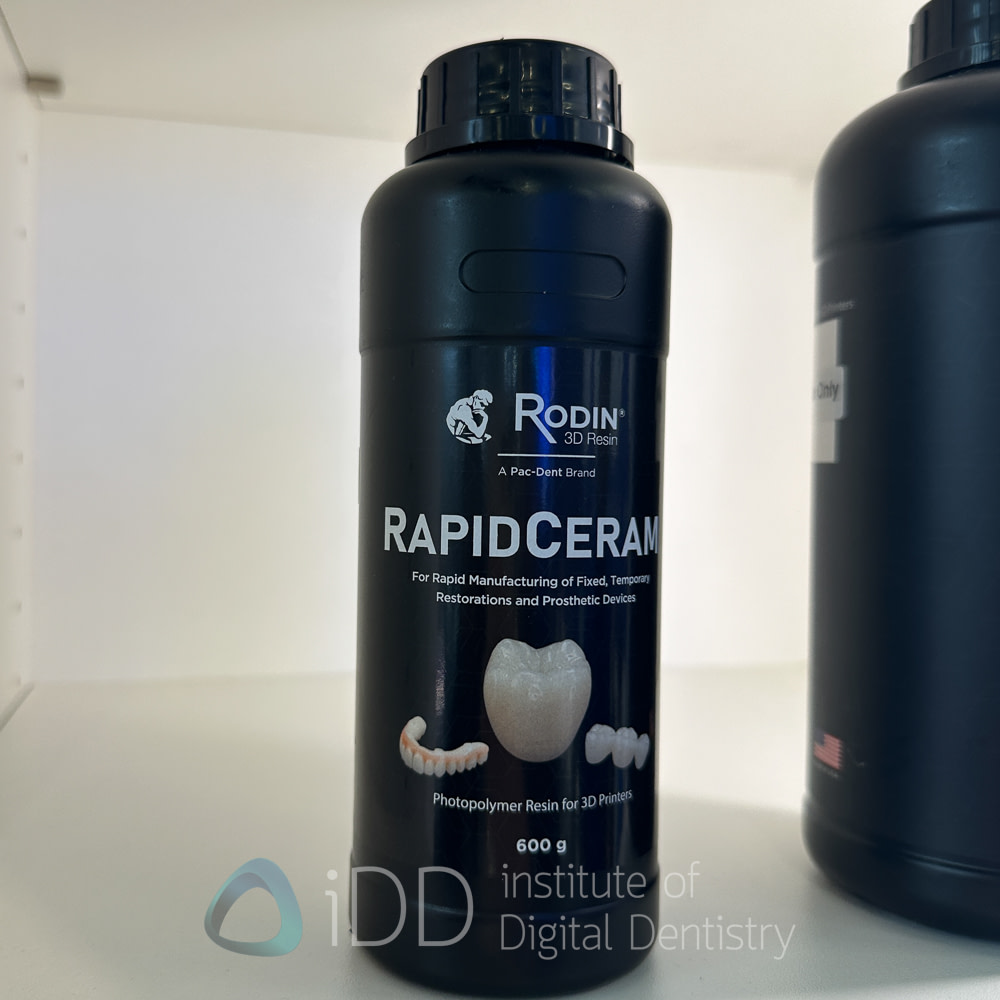
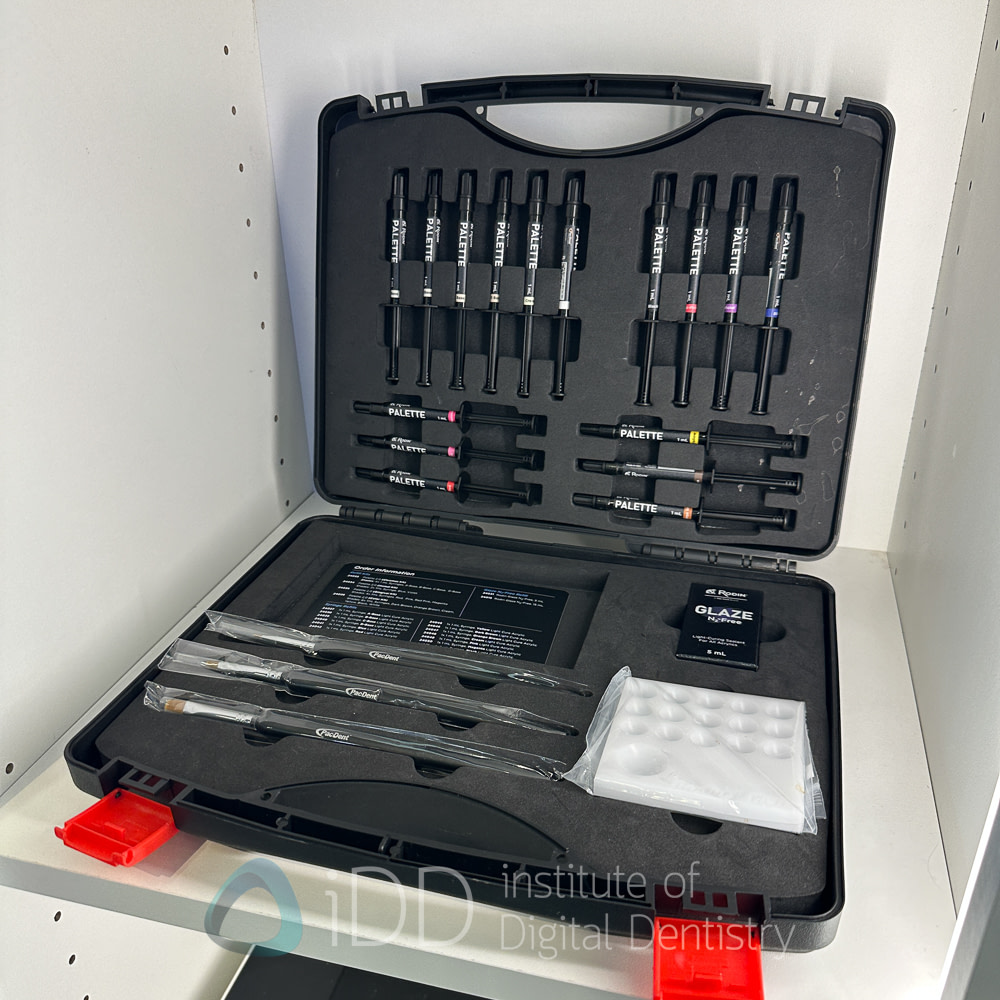
Runyes - Ambitious Manufacturer Expands Portfolio
Runyes commanded a substantial presence at IDS 2025 with an impressive booth showcasing their rapidly expanding dental technology portfolio. The Chinese manufacturer's growing prominence at international dental exhibitions reflects how dramatically the industry landscape has shifted, with companies like Runyes evolving from budget alternatives to serious competitors across multiple product categories.
Just like Chicago Midwinter, Runyes displayed their comprehensive lineup of upcoming innovations, including their wireless scanner, face scanner, and photogrammetry devices.
New at IDS was their introduction of AR goggles designed to integrate with a navigated surgery device currently under development. This expansion into the surgical navigation space represents yet another ambitious move by a company that seems determined to compete across virtually every segment of digital dentistry simultaneously.
Runyes' scattershot product development approach, developing multiple technologies across diverse categories simultaneously, stands in contrast to the more focused strategies of most established dental technology companies. Whether this broad approach will result in market-leading products remains to be seen.
What's undeniable is that Runyes and other Chinese manufacturers have significantly raised their game in recent years, evolving from producing cheap products to developing increasingly sophisticated technologies that challenge established players. Their growing presence at major international shows like IDS signals a permanent shift in the competitive landscape of dental technology.
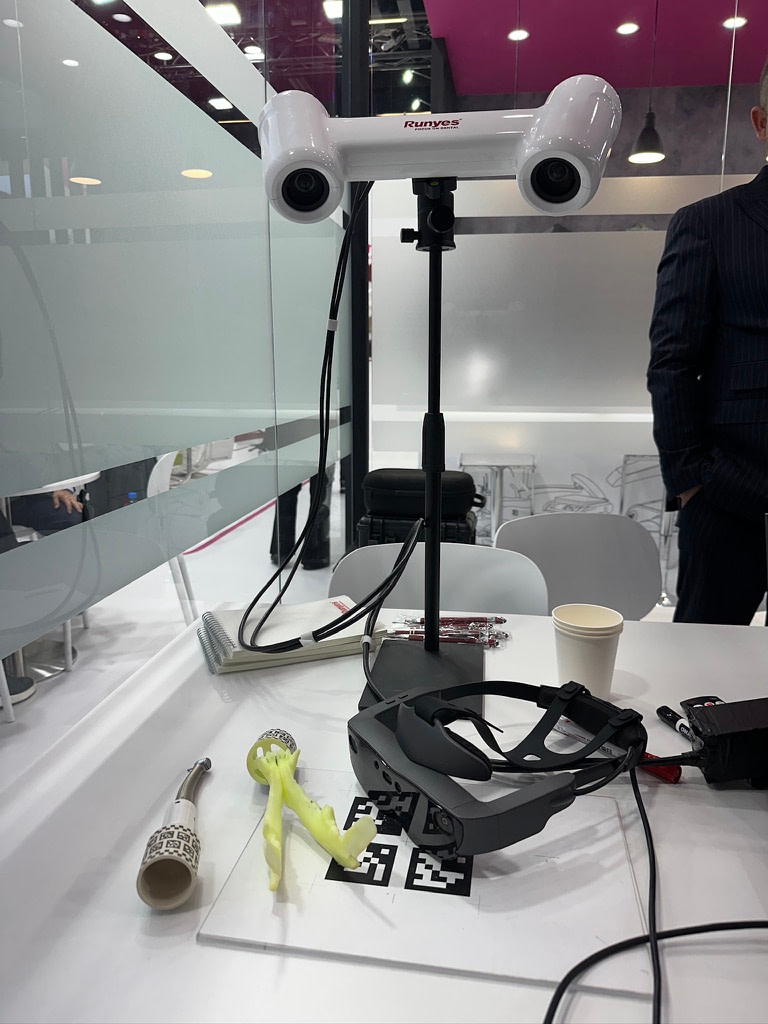
Shining 3D - Significant Ecosystem Expansion
Shining 3D showcased a comprehensive suite of innovations at IDS 2025, highlighting their evolution into a complete digital workflow provider. Their booth featured four significant products representing their full digital ecosystem:
The new wireless version of their groundbreaking Aoralscan Elite maintains all the features that made the original Elite successful - including its exceptional speed, accuracy, and revolutionary horizontal scan body system for implant scanning. While noticeably larger than its wired counterpart to accommodate the battery system, the wireless version offers 2 hours of continuous scanning per batteries the company says. This is much longer than most other wireless scanners. These batteries can be easily removed from the scanner and swapped for new (charged) ones.
Complementing their scanning technology, Shining 3D unveiled their new AccuFab F1 DLP printer, featuring impressive heating functions for both the resin tank and printing platform. The printer delivers exceptional speed and quality with light intensity up to 18 mW/cm² and intelligent residue detection that alerts users before printing begins, significantly reducing failures and preventing film damage.
The company also introduced the FabCure N2, an advanced post-curing system optimized for 3D printed parts, enhancing their manufacturing capabilities from start to finish. Nitrogen curing seems to be the best method for dealing with the oxygen-inhibition layer.
Drawing significant attention was their prototype of an all-in-one printer-wash-cure system. This concept integrates all three essential stages of the 3D printing workflow into a single unit, potentially streamlining the entire process from printing to post-processing. While still in development, this integrated approach could dramatically simplify digital manufacturing for practices with limited space or technical expertise.
The company also spoke about the addition of jaw motion tracking to their MetiSmile platform which represents a significant expansion of their diagnostic capabilities, allowing for more complete functional analysis alongside their established static scanning technologies.
They also launched their e-Motion system, an integrated solution combining intraoral scanning, photogrammetry, facial scanning, and mandibular movement tracking. This comprehensive approach to capturing both static and dynamic patient data positions Shining 3D at the forefront of comprehensive digital diagnostics and treatment planning.
The rapid pace of Shining 3D's product development continues to transform this company into to a serious competitor offering complete end-to-end solutions challenging established players in the digital dentistry space. This is one of the most exciting and innovative companies in digital dentistry right now.

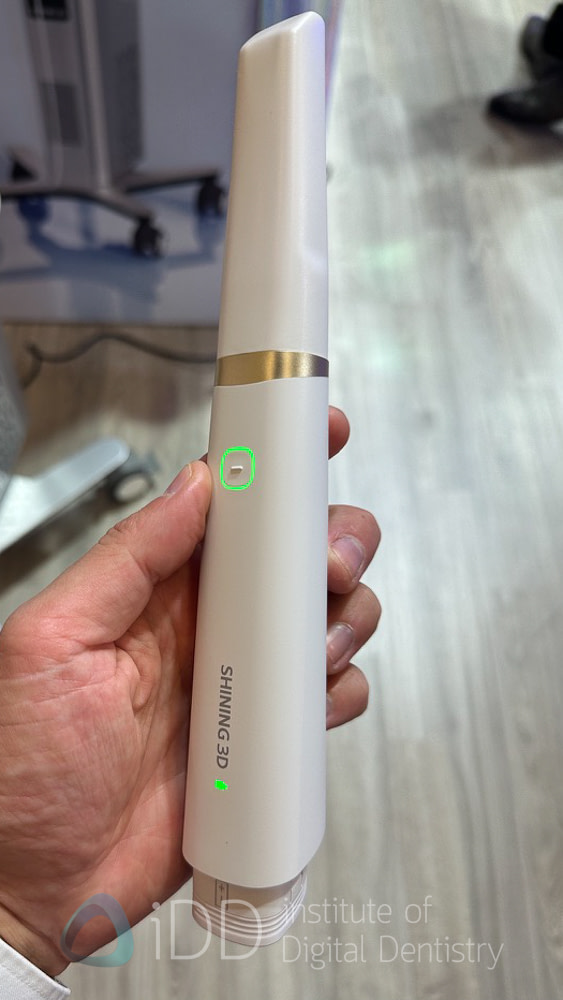
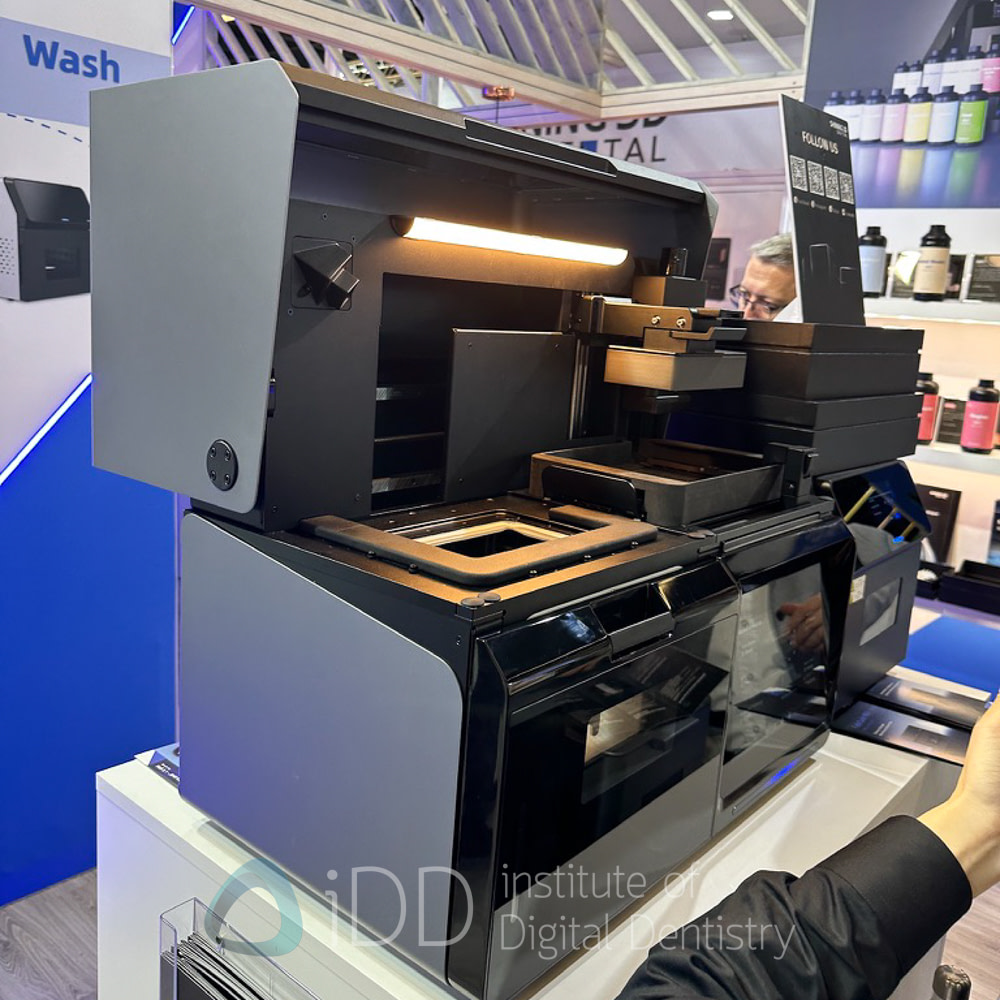
SimDensity - AI-Powered Bone Density Analysis
Visual Tech-lab showcased their SimDensity platform at IDS 2025, offering a AI-powered bone density measurement technology using existing CBCT data with a proprietary bone density phantom standard.
The technology analyzes CBCT scans to provide quantitative bone density measurements particularly valuable for pre-operative implant planning. Beyond implantology, SimDensity offers applications in orthodontic treatment planning for both clear aligner and traditional bracket systems, helping identify potential limitations or considerations related to bone density before initiating tooth movement.
What makes the system particularly practical is its seamless integration with existing CBCT technology without requiring additional patient radiation exposure. The cloud-based platform approach allows for implementation without significant hardware investments or workflow disruptions.
SimDensity represents another example of how artificial intelligence is extracting more clinical value from existing diagnostic imaging, providing quantitative data points that enhance evidence-based treatment decisions and potentially improve predictability of outcomes.
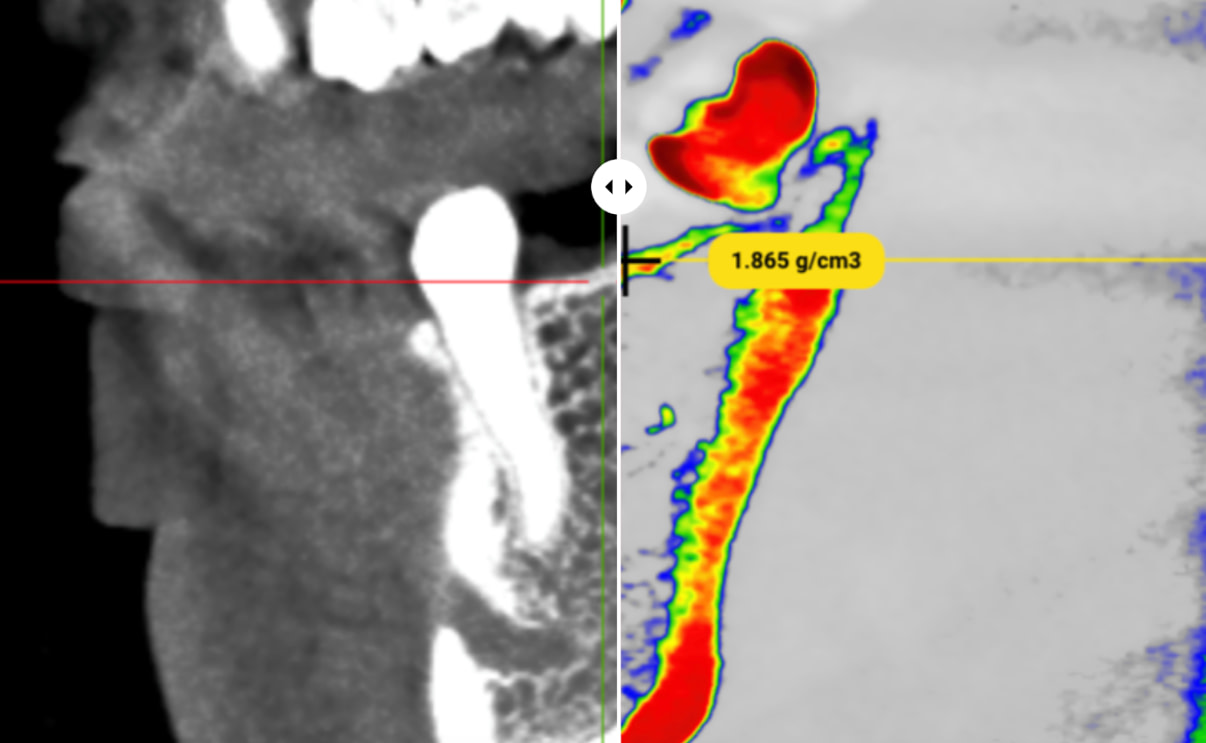
SprintRay - Expands Midas Ecosystem with New Capsule and Partnerships
SprintRay built on their successful Chicago Midwinter momentum at IDS 2025, unveiling significant expansions to their Midas ecosystem through material innovations and strategic collaborations.
SprintRay announced a major partnership with Solventum (formerly 3M Oral Care) to develop new specialized resins for the Midas platform. This collaboration with an established dental materials leader represents a significant validation of SprintRay's approach to chairside printing and promises to expand the clinical applications of their technology.
Complementing these material developments, SprintRay introduced their new multi-unit capsule specifically designed for larger restorative cases. Substantially larger than the standard Midas capsule, this innovation enables practitioners to efficiently print multiple units in a single workflow - ideal for quadrant dentistry or smile design cases.
SprintRay's strategic focus on materials and workflow enhancements demonstrates their understanding that the future of chairside printing depends on reliable, predictable clinical outcomes. By expanding both their proprietary materials and forging partnerships with established industry leaders, SprintRay continues to strengthen their position in the rapidly evolving digital restorative space.
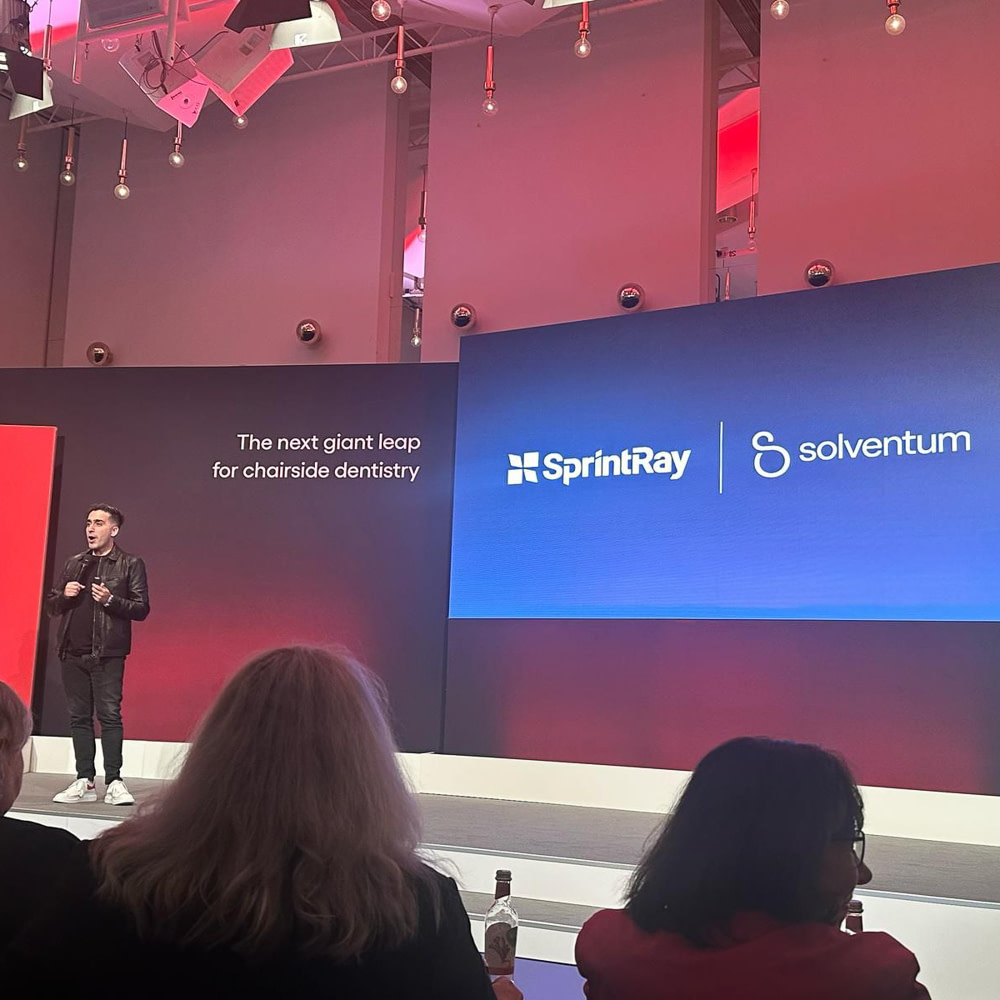
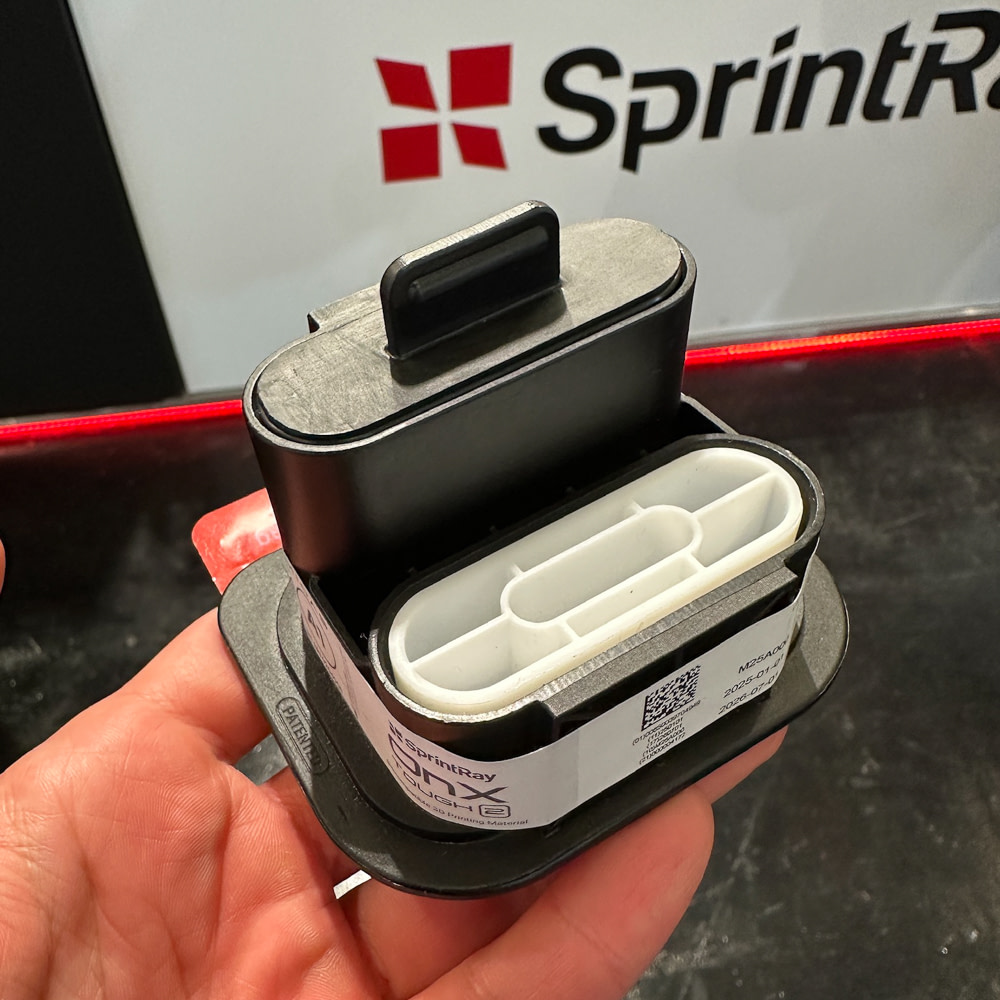
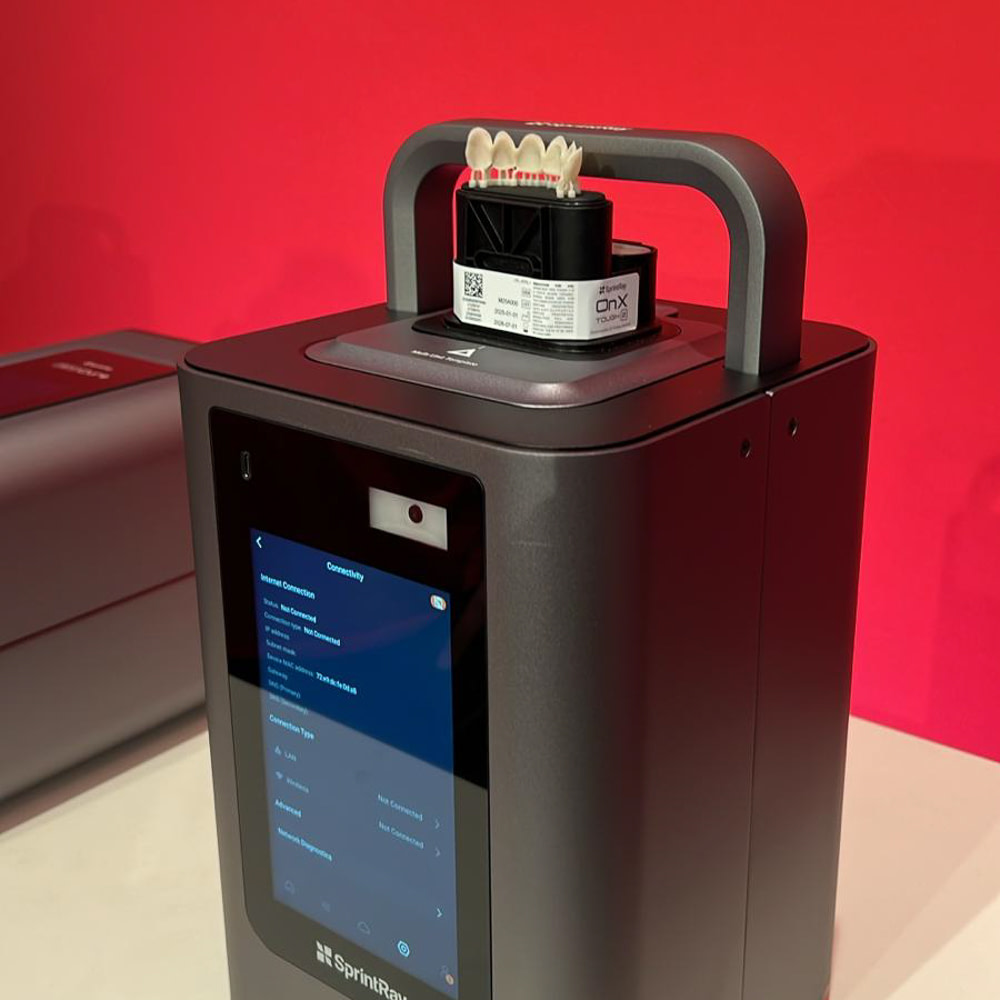
Straumann - Huge Announcement with SprintRay
In a significant industry development, Straumann announced a strategic partnership with SprintRay at IDS 2025, revealing they will distribute a branded version of the Midas chairside printing system. This Straumann-branded Midas will feature distinctive green accents, differentiating it from SprintRay's standard offering while maintaining the same disruptive technology.
This move represents a remarkable evolution for Straumann, a company traditionally focused on implants and surgical workflows. Their prominent booth at IDS featured a distinctly digital-heavy emphasis, signaling their comprehensive commitment to the digital transformation of dentistry.
The partnership is a fascinating evolution of Straumann's digital ecosystem. With their SIRIOS intraoral scanner, the addition of Midas gives them a complete chairside restoration solution - from digital impression to final printed restoration in a single appointment.
This strategic alliance between two industry powerhouses has significant implications for the dental market. It provides Straumann's extensive global distribution network with access to what many consider the most advanced chairside printing solution, while giving SprintRay unprecedented reach through Straumann's established relationships with clinicians worldwide.
The partnership reflects the accelerating convergence of implant manufacturers and digital technology providers, as the industry increasingly recognizes that comprehensive digital solutions rather than isolated products are the future of dental practice. One of the biggest announcements of the event.
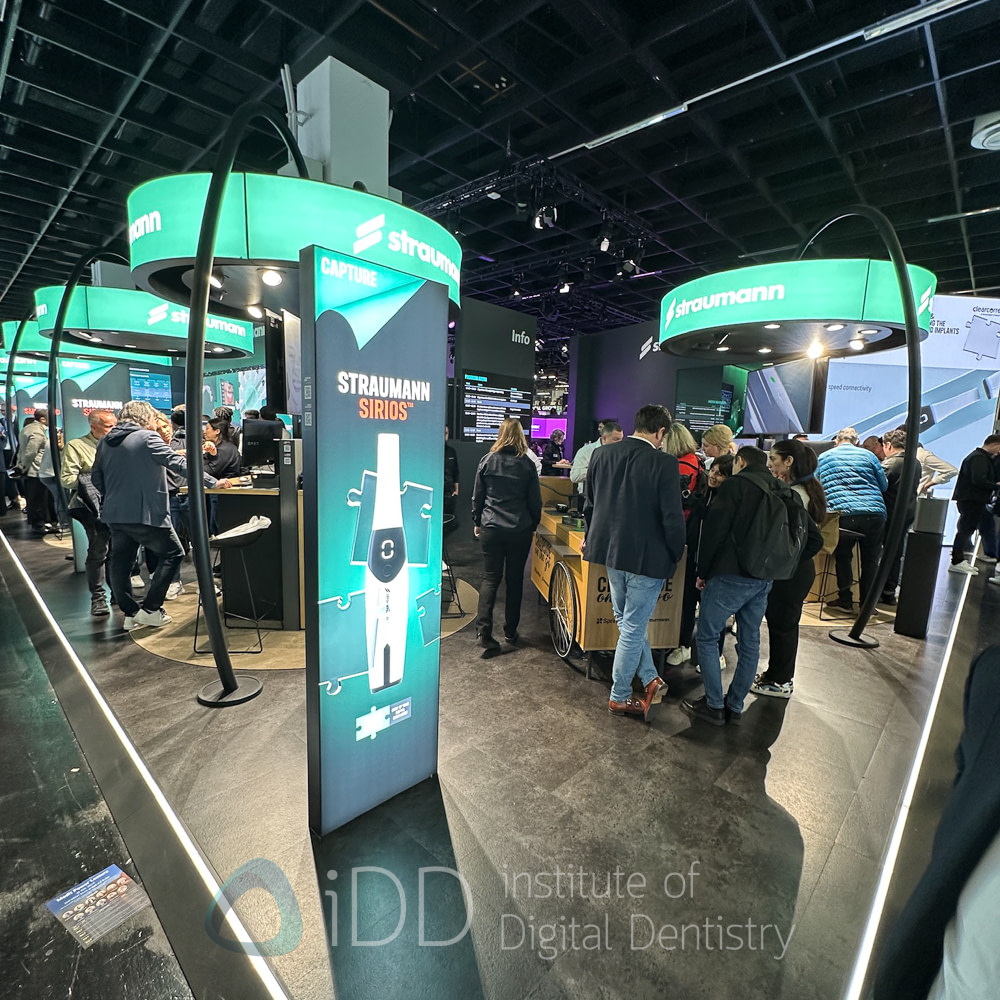
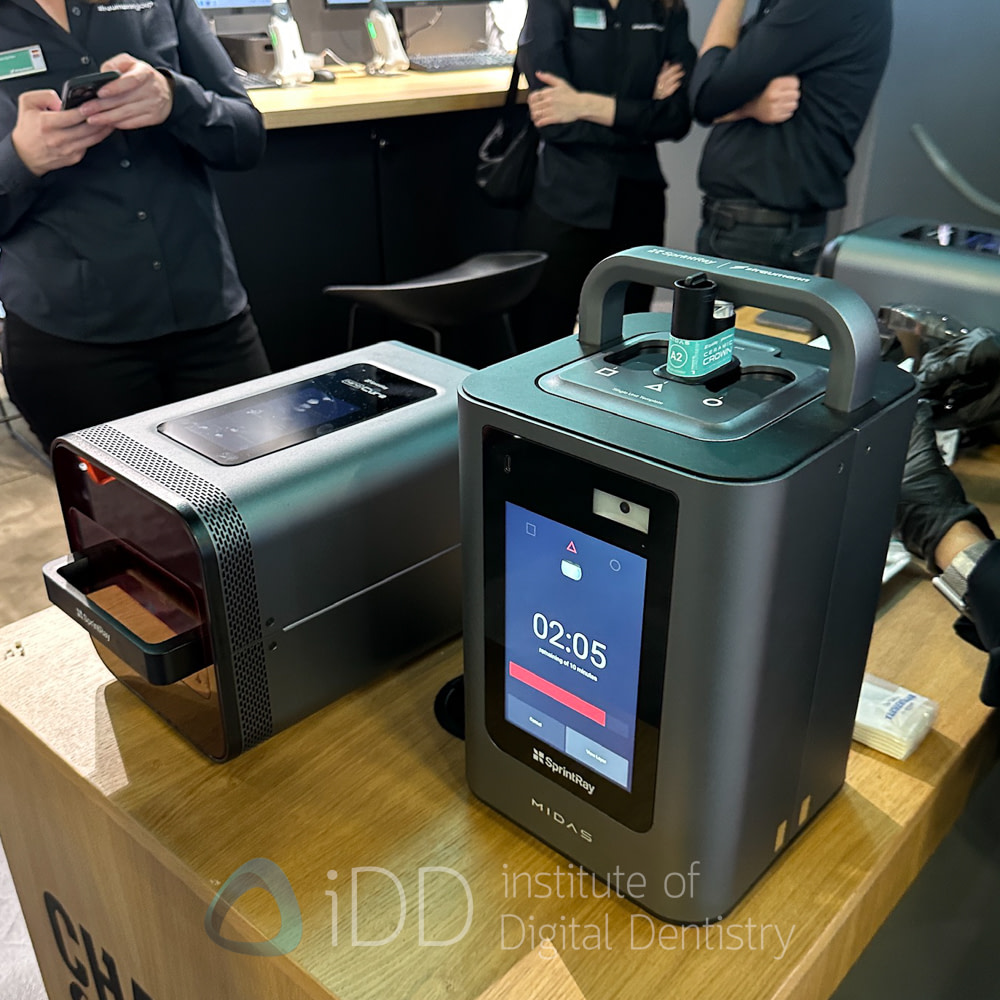
TruAbutment - Expanding the Full-Arch Digital Workflow
TruAbutment continued building on their Chicago Midwinter momentum at IDS 2025, showcasing their established IO Connect system for full-arch implant scanning alongside their iPad-based full-arch solution. Of course the 3Shape partnership was also proudly displayed.
Beyond these familiar offerings, TruAbutment showcased two significant things - their denture design software that represents a strategic expansion into the rapidly growing digital removable space, complementing their implant-focused solutions. And perhaps more technically interesting was their introduction of dual align scan bodies (effectively reverse scan bodies) designed to solve one of the most persistent challenges in digital denture workflows - accurately aligning prosthetic designs with edentulous scans.
TruAbutment's continued focus on full-arch digital workflows reflects the industry's growing emphasis on comprehensive solutions rather than isolated technologies. By addressing multiple aspects of complex implant and removable cases, they're positioning themselves as workflow specialists rather than just component manufacturers.
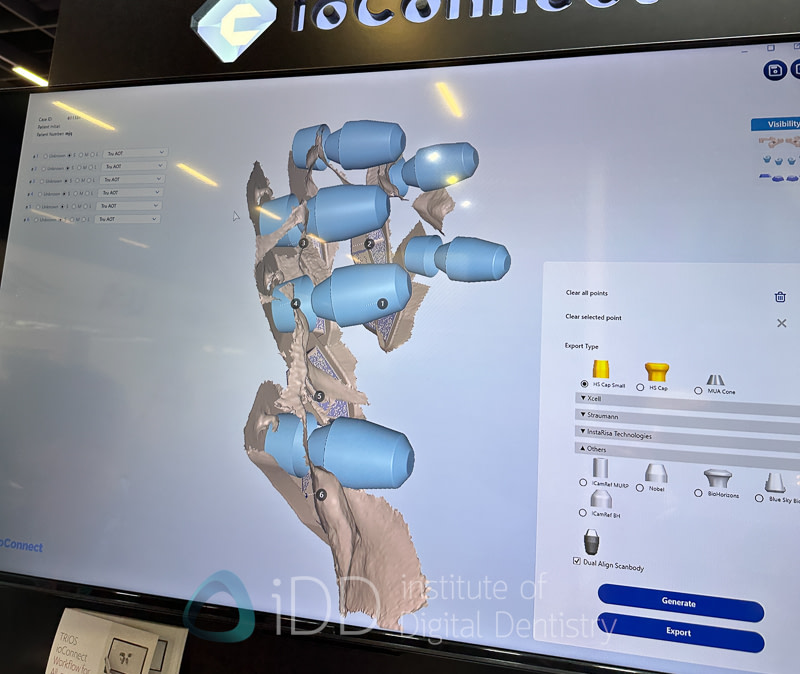
UNIZ - UBEE Printer Targets Chairside Speed
UNIZ unveiled their new UBEE printer at IDS 2025, marketed as the "World's Fastest Desktop Dental Powerhouse" and designed specifically for use in the clinic. This new model represents a significant improvement over their previous NBEE in terms of practical dental office implementation.
The UBEE utilizes Masked Stereolithography (MSLA) technology with a build volume of 198 × 124 × 180mm and resolution down to ≥100μm. Its standout feature is exceptional speed, with UNIZ claiming it can produce 8 dental models in just 5 minutes.
Beyond raw speed, the printer incorporates several dentistry-specific features, including a patented low-force separation mechanism and "micro-stereo composite peeling structures" designed to improve reliability with dental resins.
The system appears to be part of a broader UNIZ ecosystem that includes their cloud service for remote monitoring and processing, plus a smart identification system for materials. Having personally used the system, I've been impressed with its performance thus far, particularly its speed and reliability which is far improved over the NBEE model.
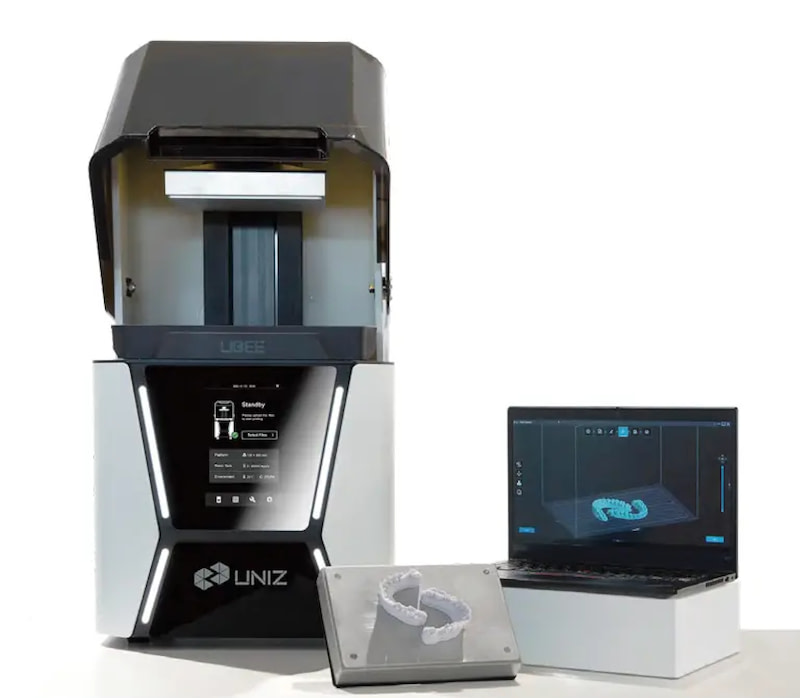
VHF - Software Revamp Takes Center Stage
VHF focused on software rather than hardware at IDS 2025, unveiling a comprehensive redesign of their CAM platform that significantly modernizes the user experience for both clinical and laboratory applications.
The completely overhauled interface features a clean, contemporary design that prioritizes intuitive navigation and simplified workflows. This substantial update addresses one of the most common criticisms of milling systems - the often outdated and complex software interfaces that can create barriers to efficient operation.
For clinical users, the new software streamlines chairside milling processes with more automated features and clearer visual guidance, reducing the learning curve for dental teams. Laboratory users benefit from enhanced production management tools designed to handle higher volumes and more complex manufacturing scenarios.
Practical enhancements include improved maintenance scheduling and monitoring, simplified tool management, and more accessible diagnostic information - all crucial for maximizing mill uptime and performance. The software appears designed to reduce the technical expertise required for routine operations while providing deeper insights for troubleshooting when needed.
While introducing no new hardware at this year's show, VHF's substantial software investment demonstrates their understanding that user experience is as crucial as mechanical capabilities in the increasingly competitive CAD/CAM market. As milling technology itself matures, the software that drives these systems becomes an increasingly important differentiator for manufacturers looking to enhance the practical value of their existing hardware platforms.
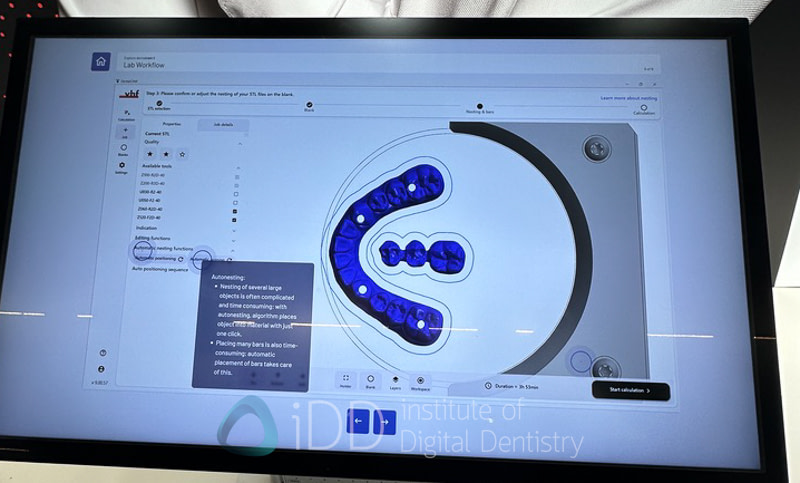
W&H - Traditional Manufacturer Makes Strategic Digital Pivot
W&H, a company traditionally known for their handpieces and surgical units, made a surprising entrance into the digital dentistry space at IDS 2025 with their new "seethrough" imaging products, including CBCT technology.
This strategic pivot represents a significant departure for a company that has built its reputation on high-quality mechanical and pneumatic dental equipment. Their venture into advanced digital imaging reflects the growing reality that traditional boundaries between dental equipment categories are rapidly dissolving, with companies expanding beyond their historical core competencies.
W&H's digital transformation raises compelling questions about the future landscape of dental manufacturing. If established analog-focused companies are now investing heavily in digital technology, it suggests we're approaching a tipping point where digital capabilities are becoming essential rather than optional for any company wanting to remain relevant in the evolving dental marketplace.
This move by W&H adds to the mounting evidence that digital transformation is no longer just for early adopters or technology specialists - it's becoming the expected standard across all segments of dental equipment manufacturing. Companies that fail to develop digital strategies risk being left behind as the industry continues its inexorable shift toward comprehensive digital workflows.
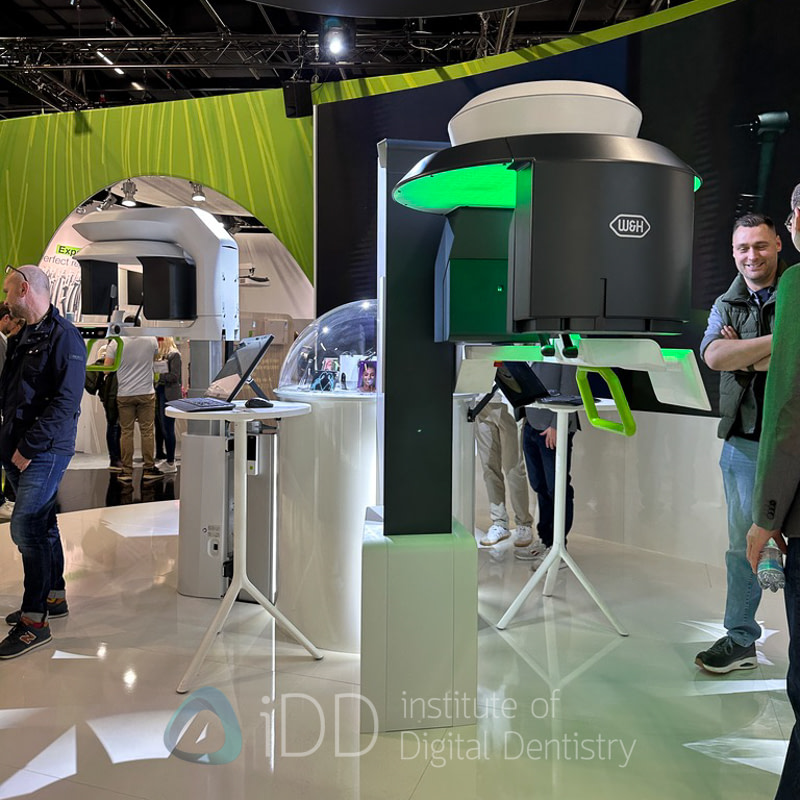
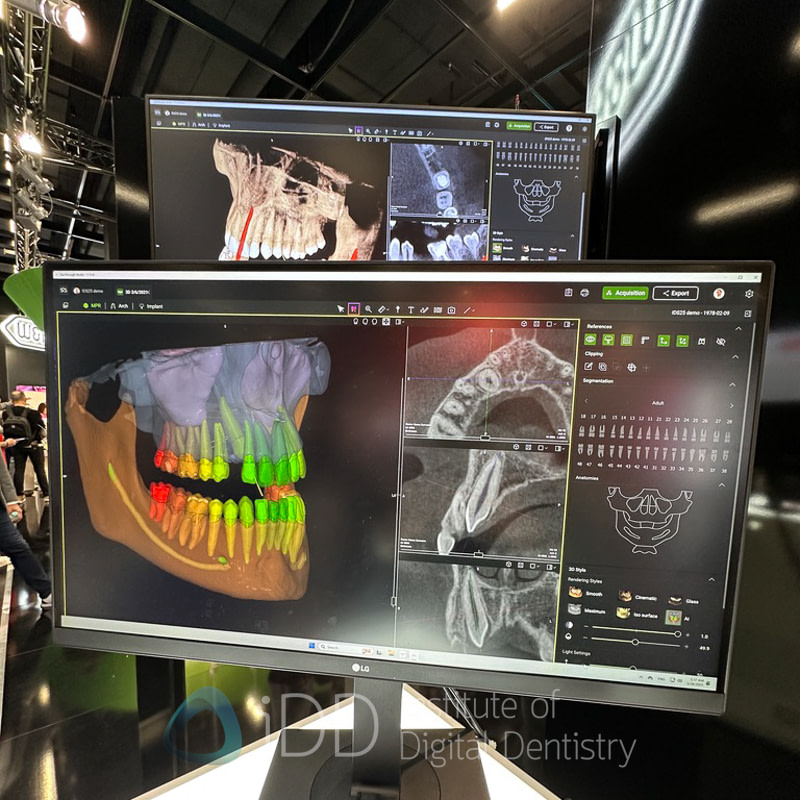
Conclusion - Digital Dentistry's Future Comes Into Focus
IDS 2025 has offered a fascinating glimpse into digital dentistry's rapidly maturing landscape. The technologies showcased this year reveal an industry moving well beyond isolated innovations toward comprehensive ecosystems and platforms that address the complete workflow. From AI-powered diagnostics to revolutionary implant solutions, chairside manufacturing breakthroughs to cloud-connected practice management, the innovations on display point to a future where digital technologies are no longer optional but fundamental to modern practice.
What's particularly striking is how the barriers to entry continue to fall across all segments of digital dentistry. Whether through more affordable hardware, simplified software interfaces, or cloud-based subscription models, manufacturers are finding innovative ways to make advanced technologies accessible to more practices regardless of size or technical expertise.
As the dust settles on another remarkable IDS, one thing is abundantly clear: the digital transformation of dentistry is accelerating, not in random bursts of technological novelty, but through thoughtful integration of complementary technologies that enhance clinical outcomes while streamlining workflows. Practices that embrace these evolving ecosystems will find themselves well-positioned to deliver the efficiency, precision, and patient-centered care that defines modern dentistry.
Thanks for reading.
Read our coverage of other recent dental events:

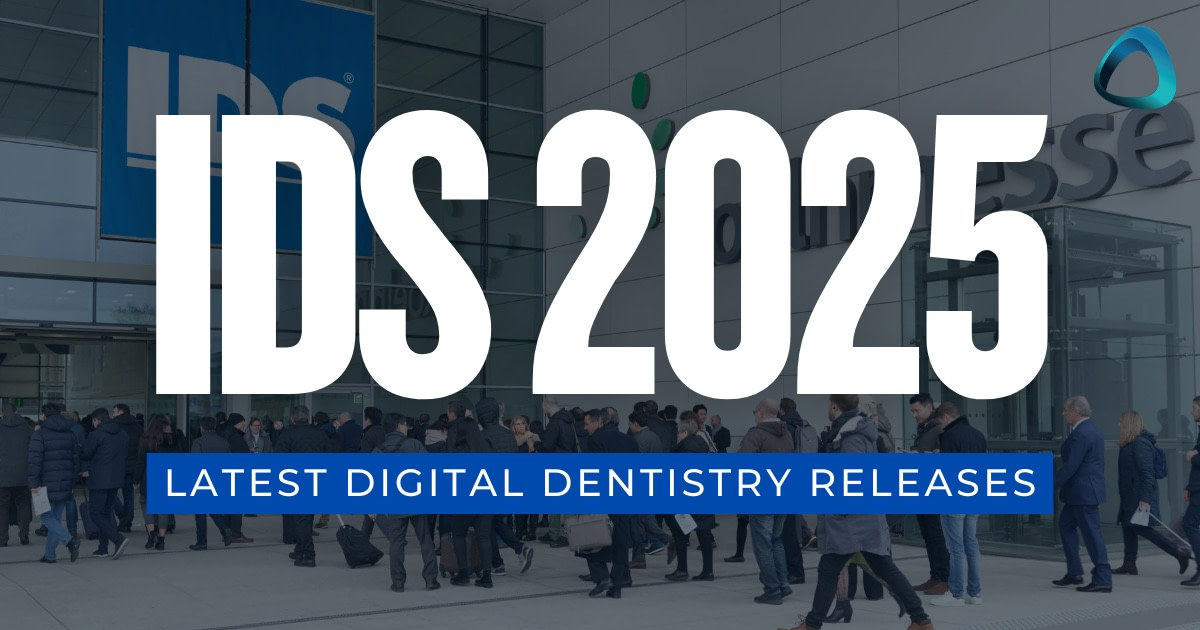
College student with an interest in dentistry here,
funny how most IOS scanners these days are marketed like iPhones. I think your quote said it best, “I genuinely dont know if clinicians buy products because of this type of marketing.”, lol
Haha, exactly! The way intraoral scanners are marketed now really does feel like tech product launches including sleek promos, buzzwords, etc. The funny thing is, dentists are supposed to be making evidence-based decisions, yet sometimes the shiny marketing seems to sway more than the clinical data.
The industry is getting commoditized.